A Review on the Weldability of Additively Manufactured Aluminium Parts by Fusion and Solid-State Welding Processes
Abstract
:1. Introduction
2. Additive Manufacturing Processes and Microstructures
3. Challenges in Welding Aluminium Alloys
4. General Overview of the Reviewed Literature
5. Fusion Welding Processes
6. Solid State Welding Processes
7. Final Considerations and Future Prospects
Author Contributions
Funding
Data Availability Statement
Conflicts of Interest
Abbreviations
| Al | Aluminium |
| AM | Additive Manufacturing |
| BM | Base Material |
| DED | Directed Energy Deposition |
| DED-Arc | Directed Energy Deposition by Arc |
| DMLM | Direct Metal Laser Melting |
| DMLS | Direct Metal Laser Sintering |
| EBW | Electron Beam Welding |
| EQZ | Equiaxed Crystal Zone |
| FL | Fusion Line |
| FSW | Friction Stir Welding |
| FZ | Fusion Zone |
| GMAW | Gas Metal Arc Welding |
| GTAW | Gas Tungsten Arc Welding |
| HAZ | Heat Affected Zone |
| LBW | Laser Beam Welding |
| MPW | Magnetic Pulse Welding |
| OR | Onion Ring |
| PAW | Plasma Arc Welding |
| PBF | Powder Bed Fusion |
| PBF-EB | Powder Bed Fusion by Electron Beam |
| PBF-LB | Powder Bed Fusion by Laser Beam |
| PMZ | Partial Melting Zone |
| RFSSW | Refill Friction Stir Spot Welding |
| RFW | Rotational Friction Welding |
| SAW | Submerged Arc Welding |
| SEM | Scanning Electron Microscope |
| SLM | Selective Laser Melting |
| TMAZ | Thermo-Mechanically Zone |
| UTS | Ultimate Tensile Strength |
| WAAM | Wire Arc Additive Manufacturing |
| WN | Weld Nugget |
| WZ | Weld Zone |
References
- Nunes, R.; Vandermeiren, N.; Verlinde, W.; Boruah, D.; Motte, R.; De Waele, W. A Benchmark of Mechanical Properties and Operational Parameters of Different Steel Filler Metals for Wire Arc Additive Manufacturing. Int. J. Adv. Manuf. Technol. 2023, 127, 599–613. [Google Scholar] [CrossRef]
- Vafadar, A.; Guzzomi, F.; Rassau, A.; Hayward, K. Advances in Metal Additive Manufacturing: A Review of Common Processes, Industrial Applications, and Current Challenges. Appl. Sci. 2021, 11, 1213. [Google Scholar] [CrossRef]
- Rasiya, G.; Shukla, A.; Saran, k. Additive Manufacturing—A Review. Mater. Today Proc. 2021, 47, 6896–6901. [Google Scholar] [CrossRef]
- ASTM ISO Standard Terminology for Additive Manufacturing: General Principles—Fundamental and Vocabulary, Astm.Org. 2022. Available online: https://www.astm.org/Standards/ISOASTM52900.htm (accessed on 10 July 2023).
- Gao, B.; Zhao, H.; Peng, L.; Sun, Z. A Review of Research Progress in Selective Laser Melting (SLM). Micromachines 2023, 14, 57. [Google Scholar] [CrossRef] [PubMed]
- Ashwath, P.; Anthony Xavior, M.; Jeyapandiarajan, P.; Joel, J.; Batako, A. Surface Finish and Property Evaluation of Direct Metal Laser Sintered (DMLS) Al-Si-10Mg alloy. J. Phys. Conf. Ser. 2022, 2198, 012055. [Google Scholar] [CrossRef]
- Çelik, A.; Tekoğlu, E.; Yasa, E.; Sönmez, M.Ş. Contact-Free Support Structures for the Direct Metal Laser Melting Process. Materials 2022, 15, 3765. [Google Scholar] [CrossRef]
- Shah, A.; Aliyev, R.; Zeidler, H.; Krinke, S. A Review of the Recent Developments and Challenges in Wire Arc Additive Manufacturing (WAAM) Process. J. Manuf. Mater. Process. 2023, 7, 97. [Google Scholar] [CrossRef]
- Gradl, P.; Tinker, D.C.; Park, A.; Mireles, O.R.; Garcia, M.; Wilkerson, R.; Mckinney, C. Robust Metal Additive Manufacturing Process Selection and Development for Aerospace Components. J. Mater. Eng. Perform. 2022, 31, 6013–6044. [Google Scholar] [CrossRef]
- Elementum 3D—An Inside Look at How AM Aluminium Alloys Are Possible Using RAM Technology. Available online: https://www.elementum3d.com/white-papers/an-inside-look-at-how-am-commercial-aluminum-alloys-are-made-possible-using-ram-technology/ (accessed on 5 June 2023).
- Migal–Wire Arc Additive Manufacturing (WAAM). Available online: https://www.migal.co/produkte/waam (accessed on 5 June 2023).
- Zhao, L.; Song, L.; Macias, J.G.S.; Zhu, Y.; Huang, M.; Simar, A.; Li, Z. Review on the correlation between microstructure and mechanical performance for laser powder bed fusion AlSi10Mg. Addit. Manuf. 2022, 56, 102914. [Google Scholar] [CrossRef]
- Macias, J.G.S.; Elangeswaran, C.; Zhao, L.; Buffiere, J.Y.; Hooreweder, B.V.; Simar, A. Fatigue crack nucleation and growth in laser powder bed fusion AlSi10Mg under as built and post-treated conditions. Mater. Des. 2021, 210, 110084. [Google Scholar] [CrossRef]
- DebRoy, T.; Mukherjee, T.; Wei, H.L.; Elmer, J.W.; Milewski, J.O. Metallurgy, mechanistic models and machine learning in metal printing. Nat. Rev. Mater. 2020, 6, 48–68. [Google Scholar] [CrossRef]
- Macias, J.G.S.; Douillard, T.; Zhao, L.; Maire, V.; Pyka, G.; Simar, A. Influence on microstructure, strength and ductility of build platform temperature during laser powder bed fusion of AlSi10Mg. Acta Mater. 2020, 201, 231–243. [Google Scholar] [CrossRef]
- Wang, J.; Zhu, K.; Zhang, W.; Zhu, X.; Lu, X. Microstructural and defect evolution during WAAM resulting in mechanical property differences for AA5356 component. J. Mater. Res. Technol. 2023, 22, 982–996. [Google Scholar] [CrossRef]
- Verma, R.P.; Pandey, K.N.; Andras, K.; Khargotra, R.; Singh, T. Difficulties and redressal in joining of aluminium alloys by GMA and GTA welding: A review. J. Mater. Res. Technol. 2023, 23, 2576–2586. [Google Scholar] [CrossRef]
- Rao, G.A.; Kumar, B.R.; Kumar, G.N.; Mahender, N.; Kumar, T.U. Study the effect process of parameters on friction welding of dissimilar metals AISI 304 steel and AA 2219 aluminium. AIP Conf. Proc. 2021, 2317, 030013. [Google Scholar] [CrossRef]
- Belyaev, S.; Vladimir, N.B.; Ivan, Y.G.; Boris, P.K.; Elena, M.L.; Bezrukikh, A.; Victor, V.L.; Vladimir, I.K.; Koptseva, N. Saturation dynamics of aluminum alloys with hydrogen. ARPN J. Eng. Appl. Sci. 2017, 12, 6243–6247. [Google Scholar]
- Silva, C.L.M.; Scotti, A. The influence of double pulse on porosity formation in aluminum GMAW. J. Mater. Process. Technol. 2006, 171, 366–372. [Google Scholar] [CrossRef]
- Cordova, L.; Bor, T.; Campos, M.; Tinga, T. Drying Strategies to Reduce the Formation of Hydrogen Porosity in Al Alloys Produced by Additive Manufacturing. II Congresso Iberoamericano de Pulvimetalurgia CEIPM. 2019. Available online: https://easychair.org/publications/preprint/V1ld (accessed on 10 July 2023).
- Olabode, M.; Kah, P.; Hiltunen, E.; Martikainen, J. Effect of Al2O3 film on the mechanical properties of a welded high-strength (AW 7020) aluminium alloy. Proc. Inst. Mech. Eng. Part B J. Eng. Manuf. 2015, 230, 2092–2101. [Google Scholar] [CrossRef]
- Lawal, L.S.; Afolalu, A.S.; Jen, T.C.; Akinlabi, E.T. Tungsten inert gas (TIG) and metal inert gas (MIG) welding applications -critical review. In Proceedings of the VIII International Conference on Advanced Agritechnologies, Environmental Engineering and Sustainable Development–AGRITECH, Krasnoyarsk, Russia, 29–31 March 2023. [Google Scholar] [CrossRef]
- Zhan, X.; Zhao, W.; Liu, Z.; Gao, Q.; Bu, H. Microstructure and porosity characteristics of 5A06 aluminum alloy joints using Laser-MIG hybrid welding. J. Manuf. Process. 2018, 35, 437–445. [Google Scholar] [CrossRef]
- Zhang, C.; Gao, M.; Zeng, X. Effect of microstructural characteristics on high cycle fatigue properties of Laser-arc hybrid welded AA6082 aluminum alloy. J. Am. Acad. Dermatol. 2016, 231, 479–487. [Google Scholar] [CrossRef]
- Ardika, R.D.; Triyono, T.; Muhayat, M. A Review Porosity in Aluminum Welding. In Proceedings of the IGF26–26th International Conference on Fracture and Structural Integrity, Turin, Italy, 26–31 May 2021. [Google Scholar] [CrossRef]
- Cong, B.; Ding, J.; Williams, S. Effect of arc mode in cold metal transfer process on porosity of additively manufactured Al-6.3% Cu alloy. Int. J. Adv. Manuf. Technol. 2015, 76, 1593–1606. [Google Scholar] [CrossRef]
- Yu, J.; Kim, D. Effects of welding current and torch position parameters on minimizing the weld porosity of zinc-coated steel. Int. J. Adv. Manuf. Technol. 2018, 95, 551–567. [Google Scholar] [CrossRef]
- Liu, W.; Wang, H.; Lu, F.; Cui, H.; Tang, X. Investigation on effects of process parameters on porosity in dissimilar Al alloy lap fillet welds. Int. J. Adv. Manuf. Technol. 2015, 81, 843–849. [Google Scholar] [CrossRef]
- Li, K.; Lu, F.; Cui, H.; Li, X.; Tang, X.; Li, Z. Investigation on the effects of shielding gas on porosity in fiber Laser welding of T-joint steels. Int. J. Adv. Manuf. Technol. 2014, 77, 1881–1888. [Google Scholar] [CrossRef]
- Katayama, S.; Naito, Y.; Uchiumi, S.; Mizutani, M. Physical phenomena and porosity prevention mechanism in Laser-arc hybrid welding. Trans. JWRI 2006, 35, 13–18. [Google Scholar]
- Chinakhov, D.A.; Vorobyev, A.V.; Grigorieva, E.G.; Mayorova, E.I. Study of Wind Velocity Impact upon the Quality of Shielding and upon the Thermal Processes under MAG Welding. Appl. Mech. Mater. 2015, 770, 253–257. [Google Scholar] [CrossRef]
- Han, Y.; Xue, S.; Fu, E.; Zhang, P. Effect of hydrogen content in ER5183 welding wire on the tensile strength and fracture morphology of Al–Mg MIG weld. Vacuum 2019, 166, 218–225. [Google Scholar] [CrossRef]
- Qiang, W.; Yingchun, G.; Baoqiang, C.; Bojin, Q. Laser cleaning of commercial Al alloy surface for tungsten inert gas welding. J. Laser Appl. 2016, 28, 022507. [Google Scholar] [CrossRef]
- Griffths, D.; Xu, L.; Gittos, M.; Allison, A.; Addison, A. High Levels of Porosity in TIG Welds Made Between Additively Manufactured Aluminium Components. Welding and Cutting. Issue 2. 2020. Available online: https://www.welding-and-cutting.info/issues/issue-2-2020 (accessed on 5 June 2023).
- Zhang, C.; Bao, Y.; Zhu, H.; Nie, X.; Zhang, W.; Zhang, S.; Zeng, X. A comparison between Laser and TIG welding of selective Laser melted AlSi10Mg. Opt. Laser Technol. 2019, 120, 105696. [Google Scholar] [CrossRef]
- Gill, M.; Terry, E.; Abdi, Y.; Hawkes, S.; Rindler, J.; Schick, D.; Ramirez, A.; Herderick, E.D. Joining Technologies for Metal Additive Manufacturing in the Energy Industry. Miner. Metals Mater. Soc. 2020, 72, 4214–4220. [Google Scholar] [CrossRef]
- Emmelmann, C.; Beckmann, F. Hybrid Lightweight Design by Laser Additive manufacturing and Laser Welding Process. In Proceedings of the Laser in Manufacturing Conference 2015, München, Germany, 22–25 June 2015. [Google Scholar]
- Biffi, C.A.; Fiocchi, J.; Tuissi, A. Laser Weldability of AlSi10Mg Alloy Produced by Selective Laser Melting: Microstructure and Mechanical Behavior. J. Mater. Eng. Perform. 2019, 28, 6714–6719. [Google Scholar] [CrossRef]
- Beckmann, F.; Emmelmann, C. Optimization of the weldability of Laser additive manufactured aluminum by means of hydrogen minimization in the component and welding parameter optimization. In Proceedings of the Laser In Manufacturing Conference 2019, München, Germany, 24–27 June 2019. [Google Scholar]
- Shi, B.; Wang, L.; Zhan, X.; Lyu, F.; Gao, Z.; Shi, H. Weld Morphology, Microstructure Evolution, and Mechanical Properties of laser Beam Welding of Wire Arc Additive Manufactured Al-Cu Substrate. Int. J. Adv. Manuf. Technol. 2022, 127, 1935–1949. [Google Scholar] [CrossRef]
- Emmelmann, C.; Beckmann, F. Optimization of Laser welding process for Laser additive manufactured aluminum parts by means of beam oscillation and process-oriented component design. In Proceedings of the Laser in Manufacturing Conference 2017, München, Germany, 26–29 June 2017. [Google Scholar]
- Cui, L.; Peng, Z.; Chang, Y.; He, D.; Cao, Q.; Guo, X.; Zeng, Y. Porosity, microstructure and mechanical property of welded joints produced by different Laser welding processes in selective Laser melting AlSi10Mg alloys. Opt. Laser Technol. 2022, 150, 107952. [Google Scholar] [CrossRef]
- Peng, Z.; Cui, L.; He, D.; Guo, X.; Zeng, Y.; Cao, Q.; Hang, H. Effect of Er and Zr addition on Laser weldability of AlSi10Mg alloys fabricated by selective Laser melting. Mater. Charact. 2022, 190, 112070. [Google Scholar] [CrossRef]
- Otten, C.; Gerhards, B.; Schleser, M.; Schwarz, A.; Gebhardt, A. Innovative Laserschweisstechnologie fur Additiv Gefertigde Bauteile; DVS Congress: Koblenz, Germany, 2022. [Google Scholar]
- Schwarz, A.; Schleser, M.; Gerhards, B.; Popoola, P.; Gebhardt, A. Welding of Additive Manufactured AlSi10Mg: Using Laser Welding in a Vacuum for High Quality Weld Seams—A New Approachto Welding LPBF Manufactured AlSi10Mg. S. Afr. J. Ind. Eng. 2021, 32, 99–112. [Google Scholar] [CrossRef]
- Chen, N.; Wan, Z.; Wang, H.; Li, J.; Yang, B.; Solomon, J.; Carlson, B. Effect of ambient pressure on Laser welding of AlSi10Mg fabricated by selected Laser melting. Mater. Des. 2022, 215, 110427. [Google Scholar] [CrossRef]
- Makikangas, J.; Rautio, T.; Mustakangas, A.; Mantyjarvi, K. Laser welding of AlSi10Mg aluminium-based alloy produced by Selective Laser Melting (SLM). In Proceedings of the 17th Nordic Laser Material Processing Conference (NOLAMPI17), Trondheim, Norway, 27–29 August 2019. [Google Scholar] [CrossRef]
- Dimatteo, V.; Liverani, E.; Ascari, A.; Fortunato, A. Weldability and Mechanical Properties of Dissimilar Laser Welded Aluminium Alloys Thin Sheets Produced by Conventional Rolling and Additive Manufacturing. J. Mater. Proc. Technol. 2022, 302, 117512. [Google Scholar] [CrossRef]
- Möller, B.; Schnabel, K.; Wagener, R.; Kaufmann, H.; Melz, T. Fatigue Assessment of Additively Manufactured AlSi10Mg Laser Beam Welded to Rolled EN AW-6082-T6 Sheet Metal. Int. J. Fatigue 2020, 140, 105805. [Google Scholar] [CrossRef]
- Nahmany, M.; Rosenthal, I.; Benishti, I.; Frage, N.; Stern, A. Electron beam welding of AlSi10Mg workpieces produced by selectedLaser melting additive manufacturing technology. Addit. Manuf. 2015, 8, 63–70. [Google Scholar] [CrossRef]
- Nahmany, M.; Stern, A.; Aghion, E.; Frage, N. Structural Properties of EB-Welded AlSi10Mg Thin-Walled Pressure Vessels Produced by AM-SLM Technology. J. Mater. Eng. Perform. 2017, 26, 4813–4821. [Google Scholar] [CrossRef]
- Nahmany, M.; Hadad, Y.; Aghion, E.; Stern, A.; Frage, N. Microstructural assessment and mechanical properties of electron beam welding of AlSi10Mg specimens fabricated by selective Laser melting. J. Mater. Proc. Technol. 2019, 270, 228–240. [Google Scholar] [CrossRef]
- Michler, M.; Hollmann, P.; Zenker, R.; Buchwalder, A. Investigation of pore Reduction in Hybrid Joints of Conventionally and Additively Manufactured AlSi10Mg Using Electron Beam Welding. Adv. Eng. Mater. 2021, 23, 2001325. [Google Scholar] [CrossRef]
- Scherillo, F.; Astarita, A.; di Martino, D.; Contaldi, V.; di Matteo, L.; di Petta, P.; Casarin, R.; Squillace, A.; Langella, A. On the microstructure analysis of FSW joints of aluminium components made via direct metal Laser sintering. AIP Conf. Proc. 2017, 1896, 040007. [Google Scholar] [CrossRef]
- Scherillo, F.; Astarita, A.; Prisco, R.; Contaldi, V.; di Petta, P.; Langella, A.; Squillace, A. Friction Stir Welding of AlSi10Mg Plates Produced by Selective Laser Melting. Metallography. Met. Microstruct. Anal. 2018, 7, 457–463. [Google Scholar] [CrossRef]
- El Hassanin, A.; Velotti, C.; Scherillo, F.; Astarita, A.; Squillace, A.; Carrino, L. Study of the solid state joining of additive manufactured components. In Proceedings of the IEEE 3rd International Forum on Research and Technologies for Society and Industry (RTSI), Modena, Italy, 11–13 September 2017. [Google Scholar] [CrossRef]
- Du, Z.; Chen, H.C.; Tan, M.J.; Bi, G.; Chua, C.K. Investigation of porosity reduction, microstructure and mechanical properties for joining of selective Laser melting fabricated aluminium composite via friction stir welding. J. Manuf. Process. 2018, 36, 33–43. [Google Scholar] [CrossRef]
- Abu Bakar, S.S.S.; Sharif, S.; Faridh, M. Assessment of Friction Stir Welding on Aluminium 3D Printing Materials. Int. J. Recent Technol. Eng. 2019, 4, 10975–10980. [Google Scholar] [CrossRef]
- Du, Z.; Tan, M.J.; Chen, H.; Bi, G.; Chua, C.K. Joining of 3D-printed AlSi10Mg by friction stir welding. Weld. World 2018, 62, 675–682. [Google Scholar] [CrossRef]
- Minhas, N.; Sharma, V.; Bhadauria, S.S. Echancing the Properties of Friction Stir Welded Joints of L-PBF Printed AlSi10Mg Alloy via Multi-Variable Optimization. Arch. Civ. Mech. Eng. 2023, 23, 60. [Google Scholar] [CrossRef]
- Thakur, A.; Mehlwal, S.; Minhas, N.; Sharma, V. Influence of Tool Rotational Speed on the Microstructural Characterization and Mechanical Properties of Friction Stir Welded Al-Si10Mg Parts Produced by DMLS Additive Manufacturing Process. Mater. Sci. Eng. B 2022, 278, 115612. [Google Scholar] [CrossRef]
- Moeini, G.; Sajadifar, S.V.; Wegener, T.; Rossler, C.; Gerber, A.; Bohm, S.; Niendorf, T. On the influence of build orientation on properties of friction stir welded AleSi10Mg parts produced by selective Laser melting. J. Mater. Res. Technol. 2021, 12, 1446–1460. [Google Scholar] [CrossRef]
- Napolitano, F.; El Hassanin, A.; Scherillo, F.; Squillace, A. FSW of Extruded and Additively Manufactured Parts for Automotive Components. Mater. Manuf. Process. 2023, 38, 1445–1454. [Google Scholar] [CrossRef]
- Moeini, G.; Sajadifar, S.V.; Wegener, T.; Brenne, F.; Niendorf, T.; Bohm, S. On the low-cycle fatigue behavior of friction stir welded Al–Si12 parts produced by selective Laser melting. Mater. Sci. Eng. A 2019, 764, 138189. [Google Scholar] [CrossRef]
- Hatzky, M.; Bohm, S. Untersuchung und Witerentwicklung von Reibschweiss-verfahren zum Verbiden Additiv Gefertigter Bauteile. Schweissen und Schneiden. Vol 74. 2022. Available online: https://www.welding-and-cutting.info/article/investigation-and-further-development-of-friction-welding-for-joining-additively-manufactured-components (accessed on 5 June 2023).
- Krochmal, M.; Rajan, A.N.R.; Moeini, G.; Sajadifar, S.V.; Wegener, T.; Niendorf, T. Microstructural and mechanical properties of AlSi10Mg: Hybrid welding of additively manufactured and cast parts. J. Mater. Res. 2022, 38, 297–311. [Google Scholar] [CrossRef]
- Mirandola, P.; Lunetto, V.; Novel, D.; Barozzi, M.; Bellutti, P.; De Maddis, M.; Spena, P.R. Strength and Microscture of Friction Stir Welded Additively Manufactured Scalmalloy® is As-Welded and Heat-Treated Conditions. J. Manuf. Process. 2023, 97, 1–11. [Google Scholar] [CrossRef]
- Thakur, A.; Sharma, V.; Minhas, N.; Manda, S.; Sharma, V.S. Microstructure and Mechanical Properties of Dissimilar Friction Stir Welded Joints of Laser Powder Bed Fusion Processed AlSi10Mg and Conventional Hot Rolled 6061-T6 Thin Sheet. Opt. Laser Technol. 2023, 163, 109382. [Google Scholar] [CrossRef]
- Zhou, S.; Wu, K.; Yang, G.; Wu, B.; Qin, L.; Guo, X. Friction Stir Welding of Wire Arc Additively Manufactured 205A Aluminum Alloy: Microstructure and Mechanical Properties. Mater. Sci. Eng. A 2023, 876, 145154. [Google Scholar] [CrossRef]
- Fritsche, S.; Draper, J.; Toumpis, A.; Galloway, A.; Amacio-Filho, S.T. Refill friction stir spot welding of AlSi10Mg alloy produced by Laser powder bed fusion to wrought AA7075-T6 alloy. Manuf. Lett. 2022, 34, 78–81. [Google Scholar] [CrossRef]
- Prashanth, K.G.; Damodaram, R.; Scudino, S.; Wang, Z.; Rao, K.P.; Eckert, J. Friction welding of Al–12Si parts produced by selective Laser melting. Mater. Des. 2014, 57, 632–637. [Google Scholar] [CrossRef]
- Shribman, V.; Nahmany, M.; Levi, S.; Atiya, O.; Ashkenazi, D.; Stern, A. MP Welding of Dissimilar Materials: AM Laser Powder-Bed Fusion AlSi10Mg to Wrought AA6060-T6. Prog. Addit. Manuf. 2019, 5, 171–181. [Google Scholar] [CrossRef]
- Zhao, L.; Macias, J.G.S.; Ding, L.; Idrissi, H.; Simar, A. Damage mechanisms in selective laser melted AlSi10Mg under as built and different post-treatment conditions. Mater. Sci. Eng. A 2019, 764, 138210. [Google Scholar] [CrossRef]
- Wu, H.; Ren, Y.; Re, J.; Liang, L.; Li, R.; Fang, Q.; Cai, A.; Shan, Q.; Tian, Y.; Baker, I. Selective laser melted AlSi10Mg alloy under melting mode transition: Microstructure evolution, nanomechanical behaviors and tensile properties. J. Alloy Compd. 2021, 873, 159823. [Google Scholar] [CrossRef]
- Bhavar, V.; Kattire, R.; Patil, V.; Khot, S.; Gujar, K.; Singh, R. A Review on Powder Bed Fusion technology of Metal Additive Manufacturing. In Proceedings of the 4th International Conference and Exhibition on Additive Manufacturing Technologies, Banglore, India, 1–2 September 2014. [Google Scholar]
- Fedina, T.; Belelli, F.; Lupi, G.; Brandau, B.; Casati, R.; Berneth, R.; Brueckner, F.; Kaplan, A.F.H. Influence of AlSi10Mg Powder Aging on the Material Degradation and its Processing in Laser Powder Bed Fusion. Powder Technol. 2022, 412, 118024. [Google Scholar] [CrossRef]
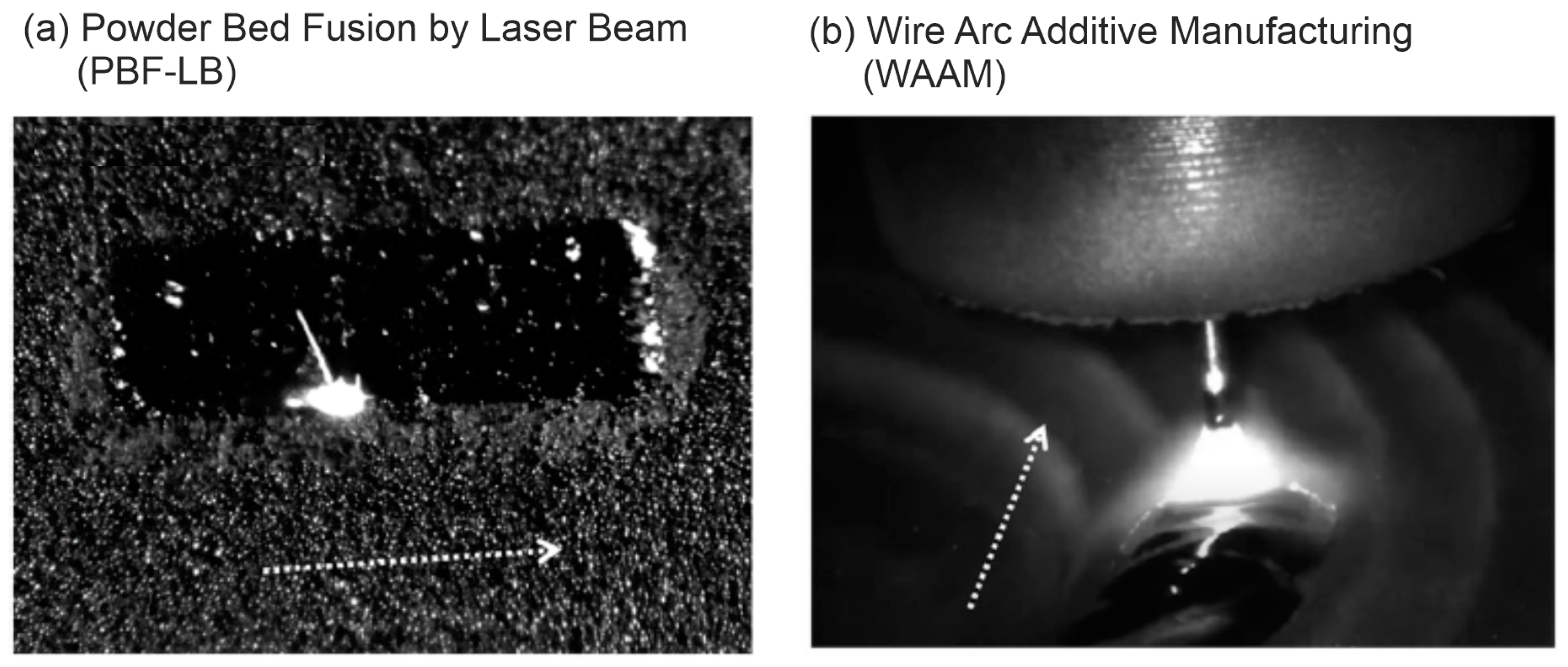
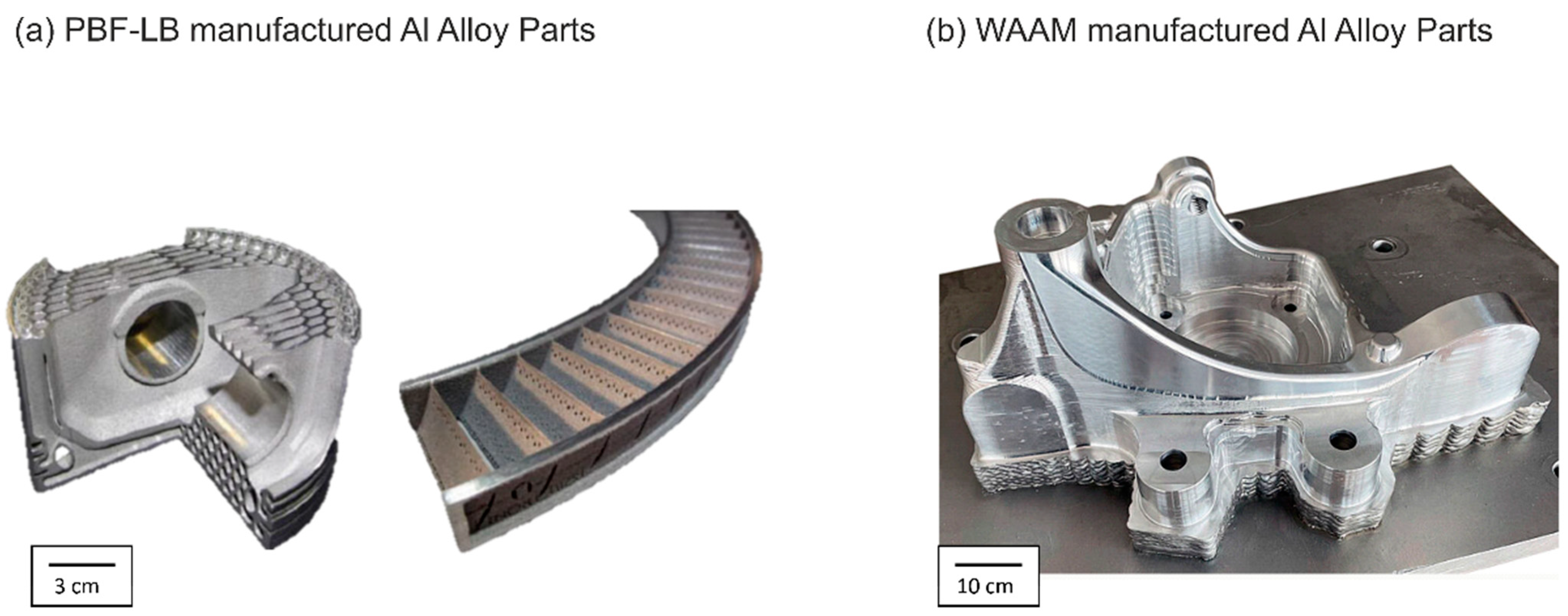
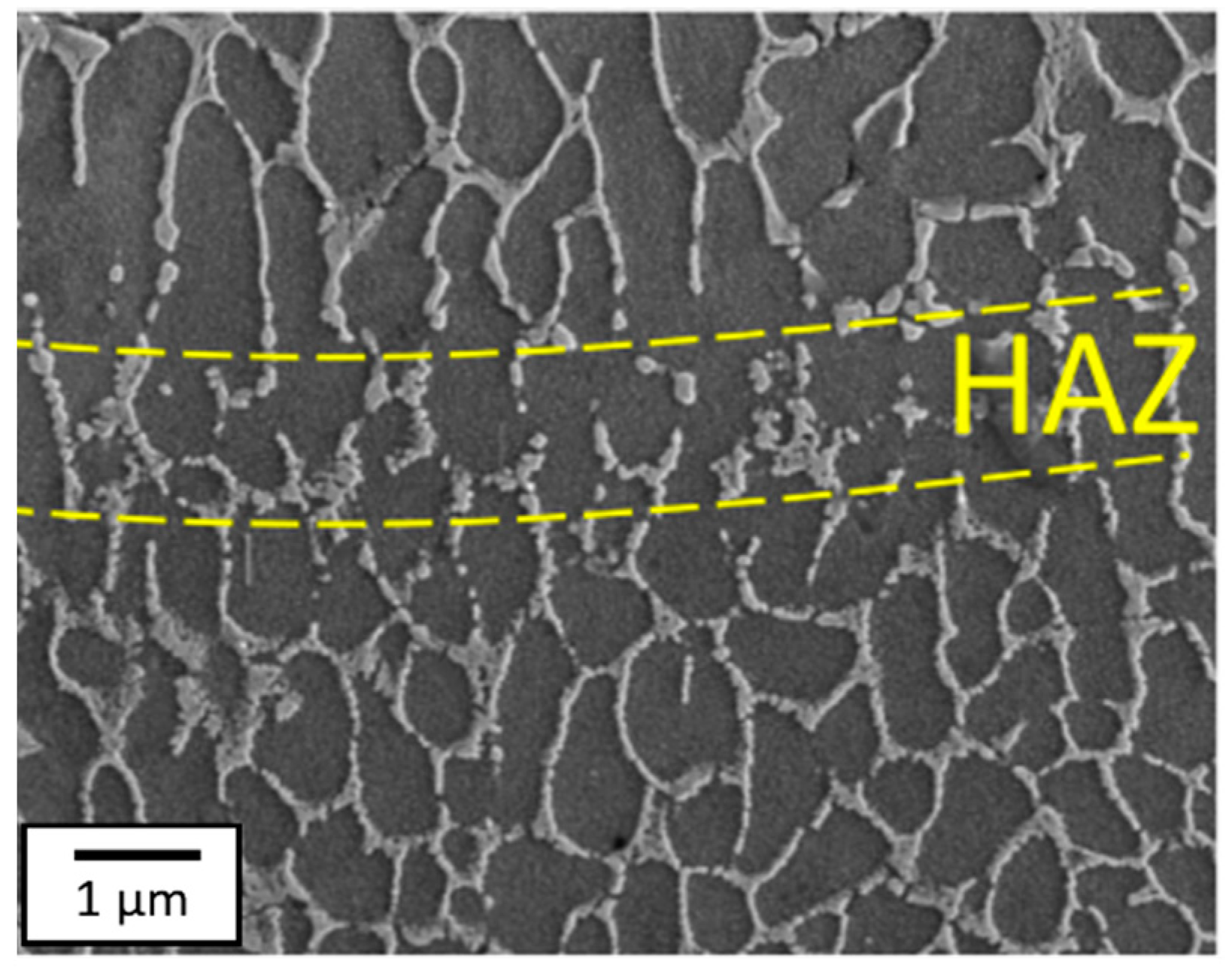
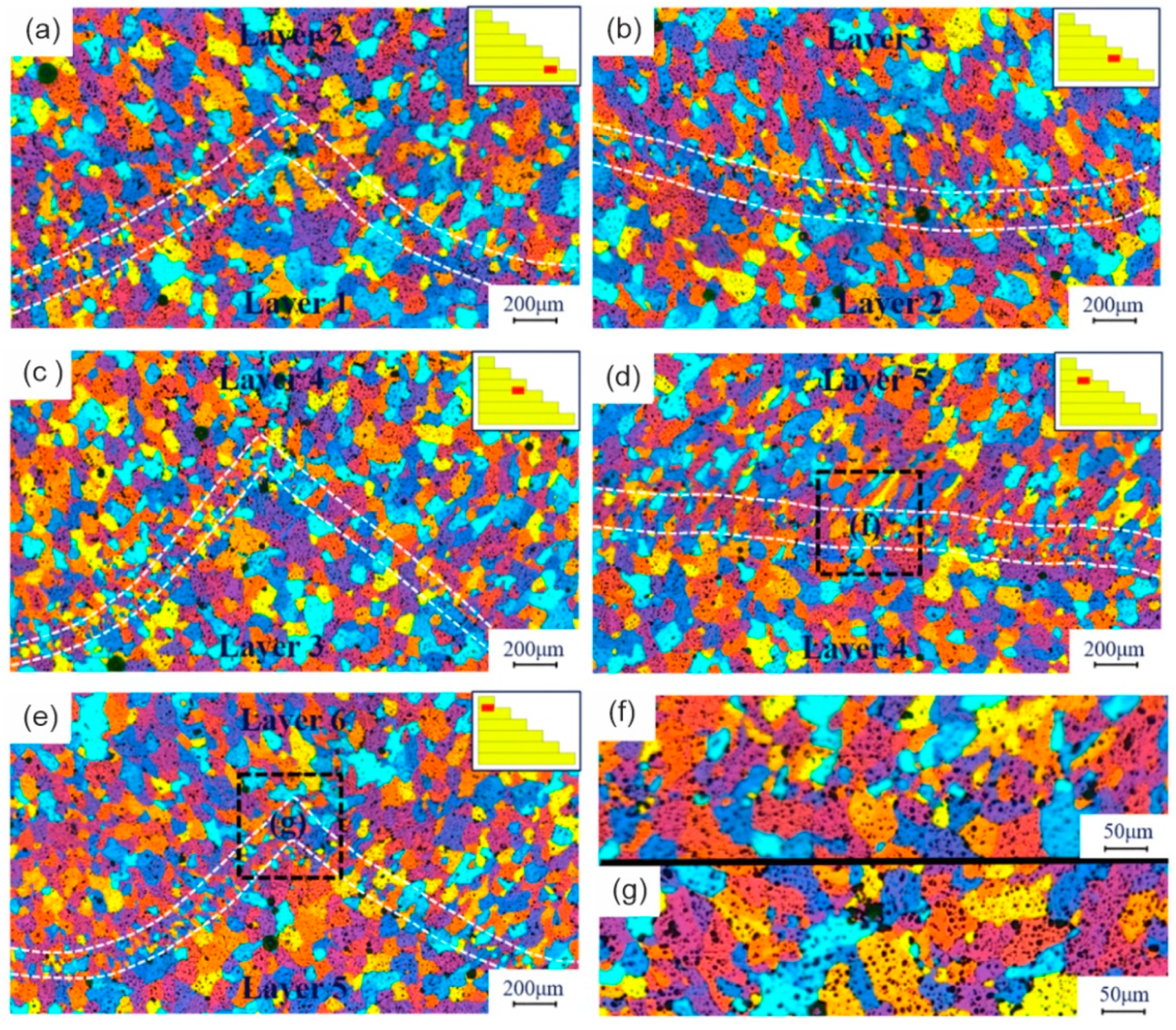

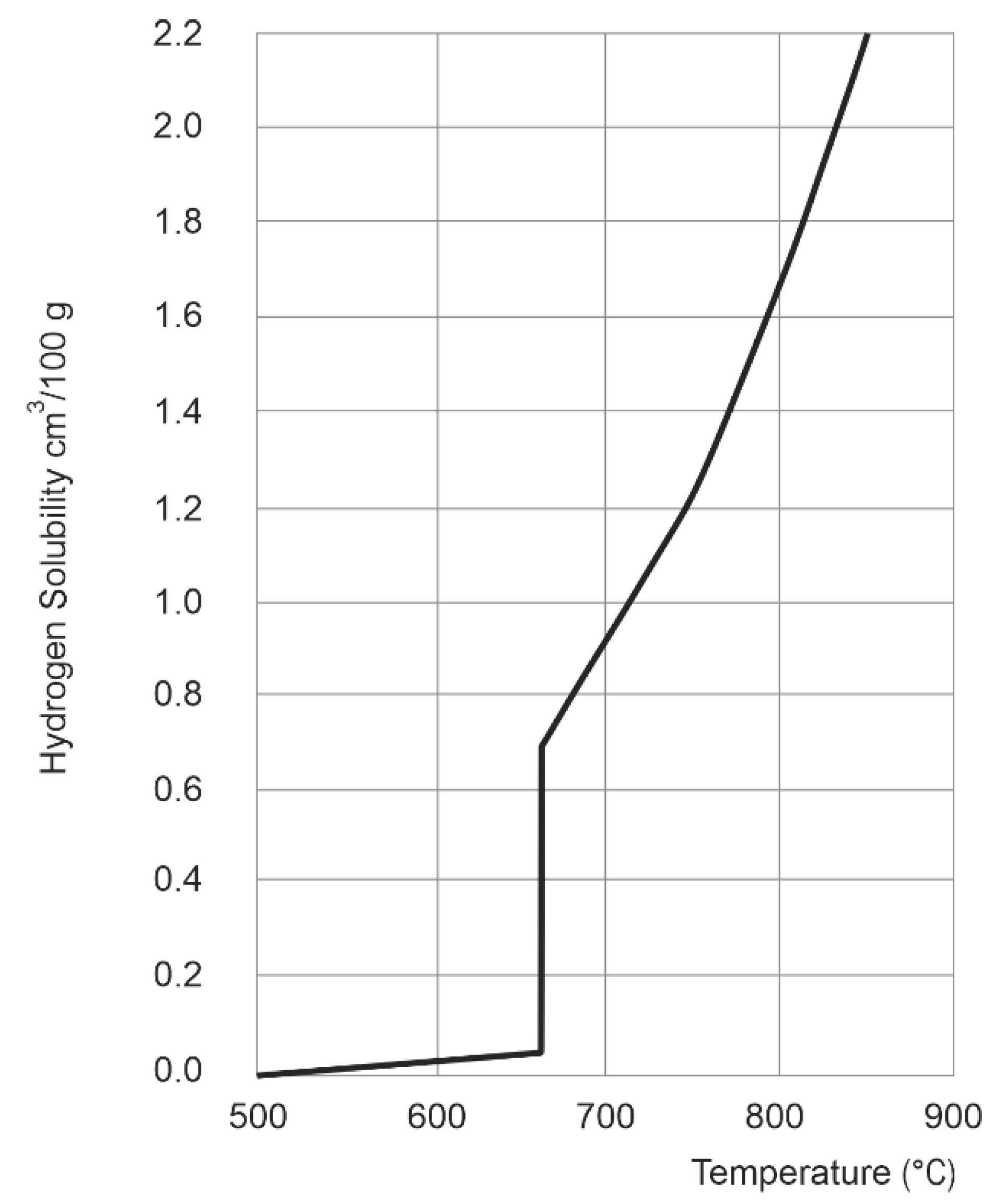

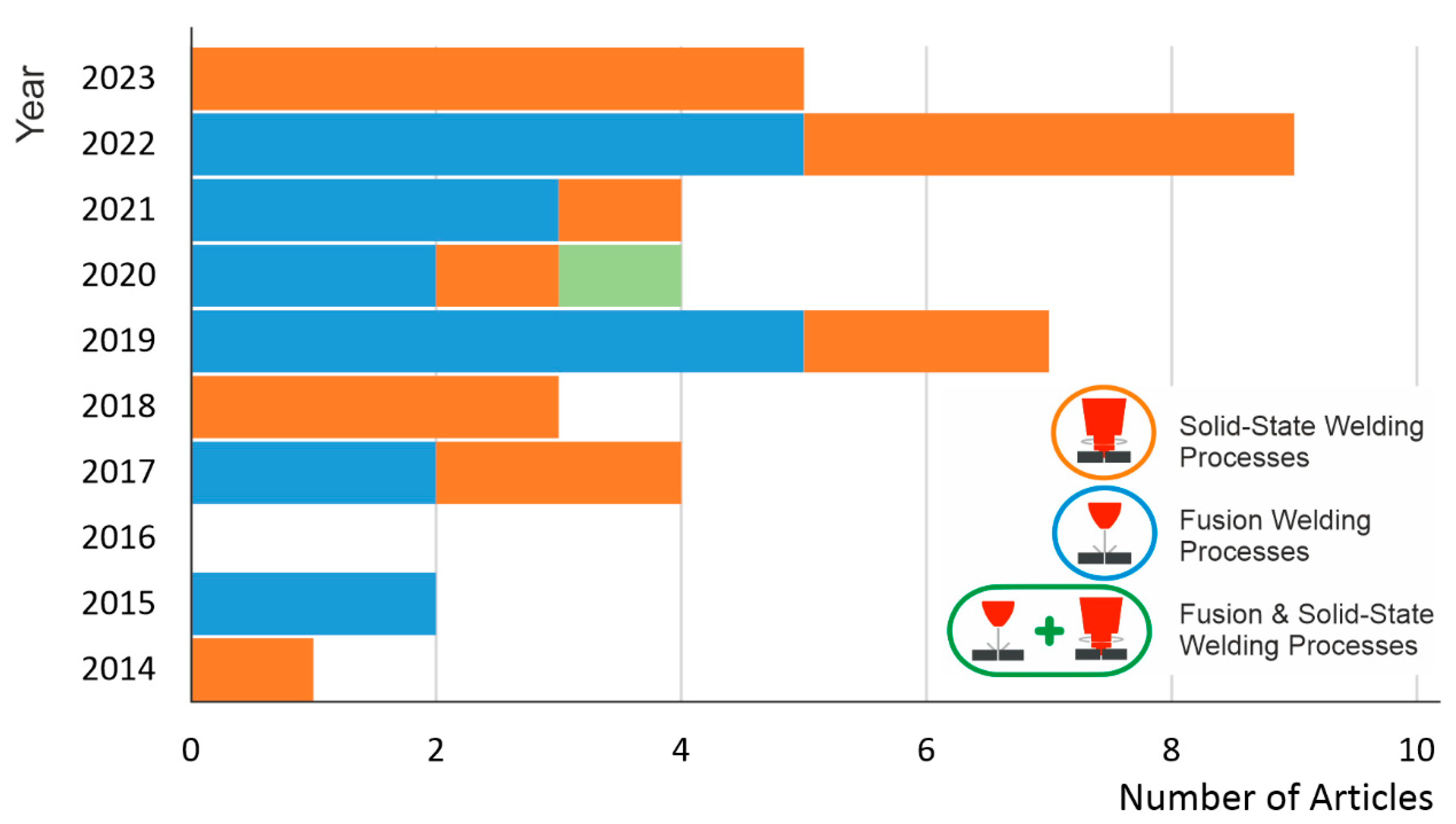
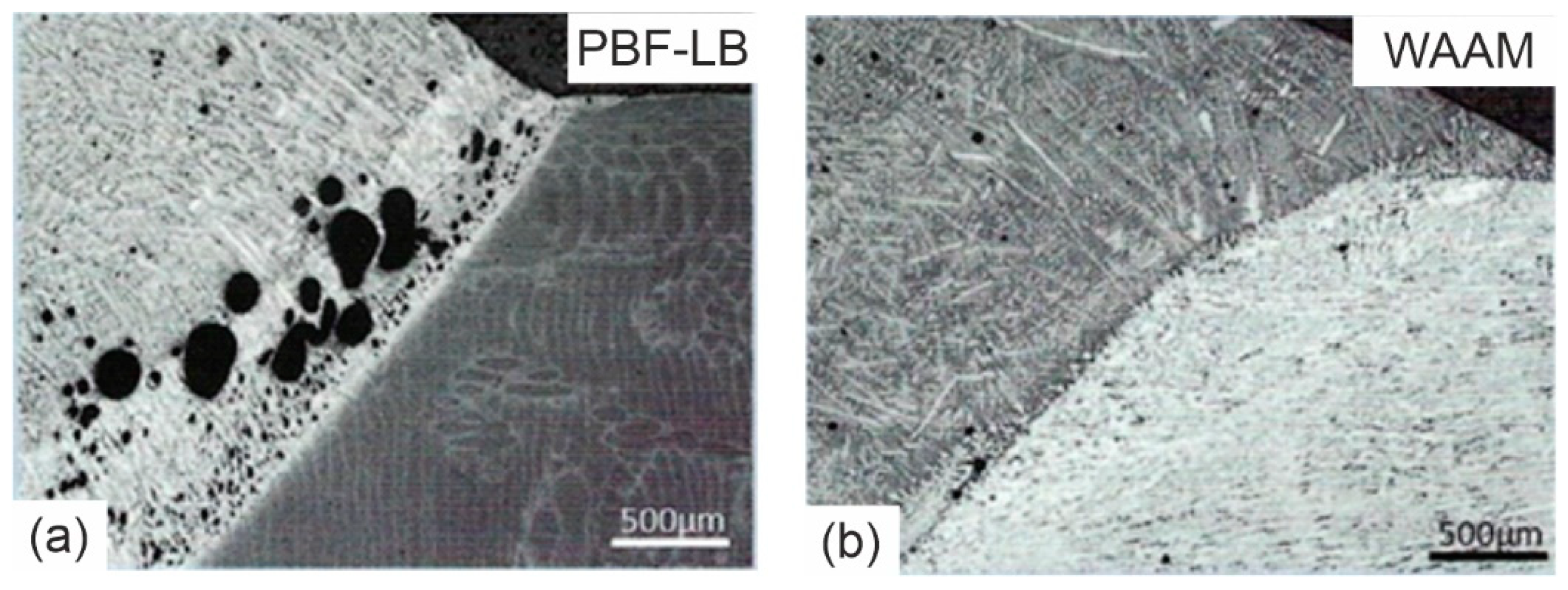
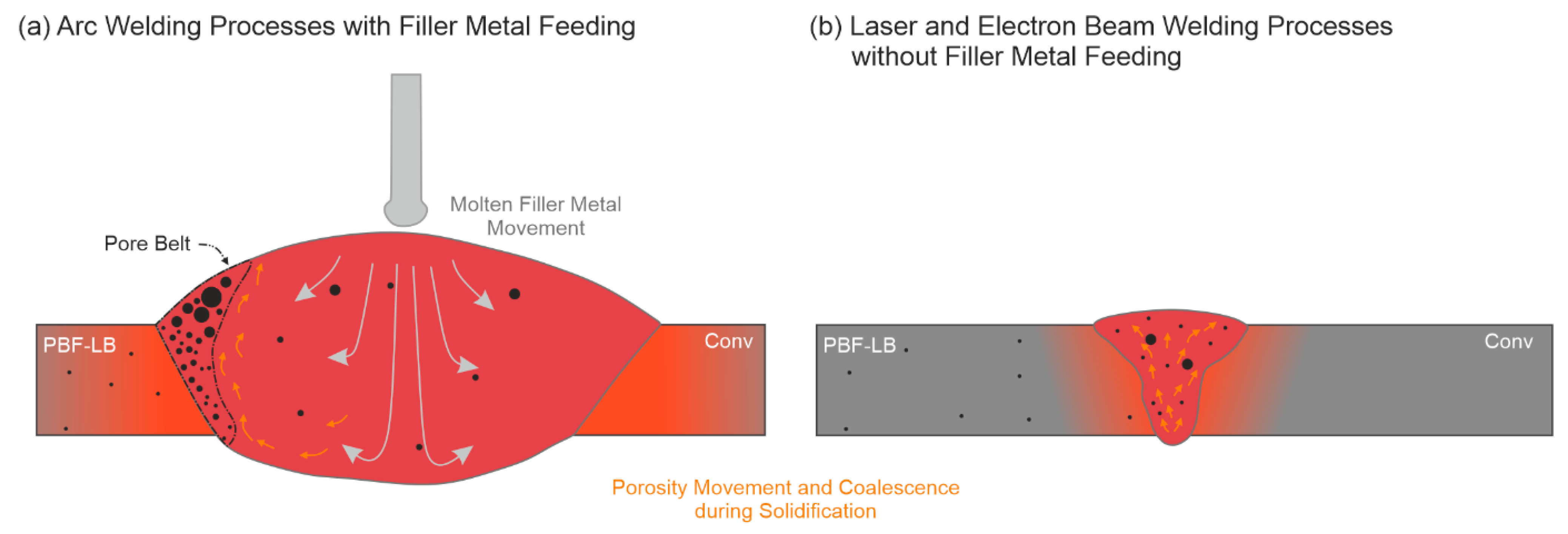
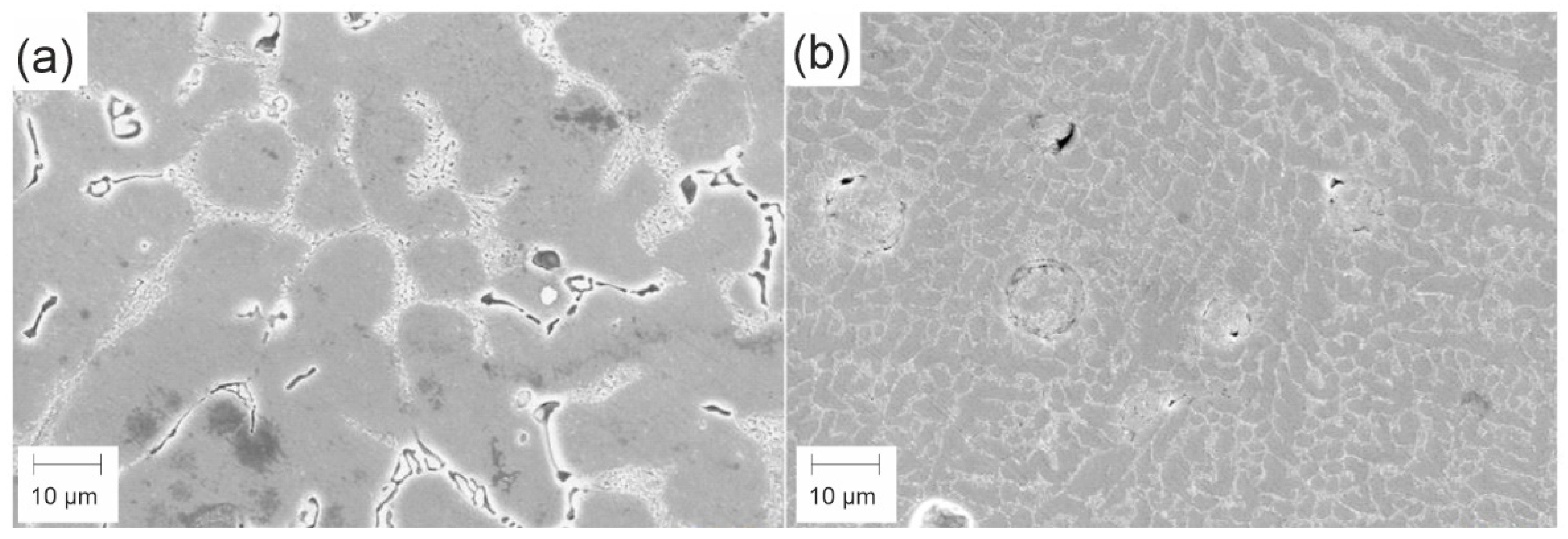


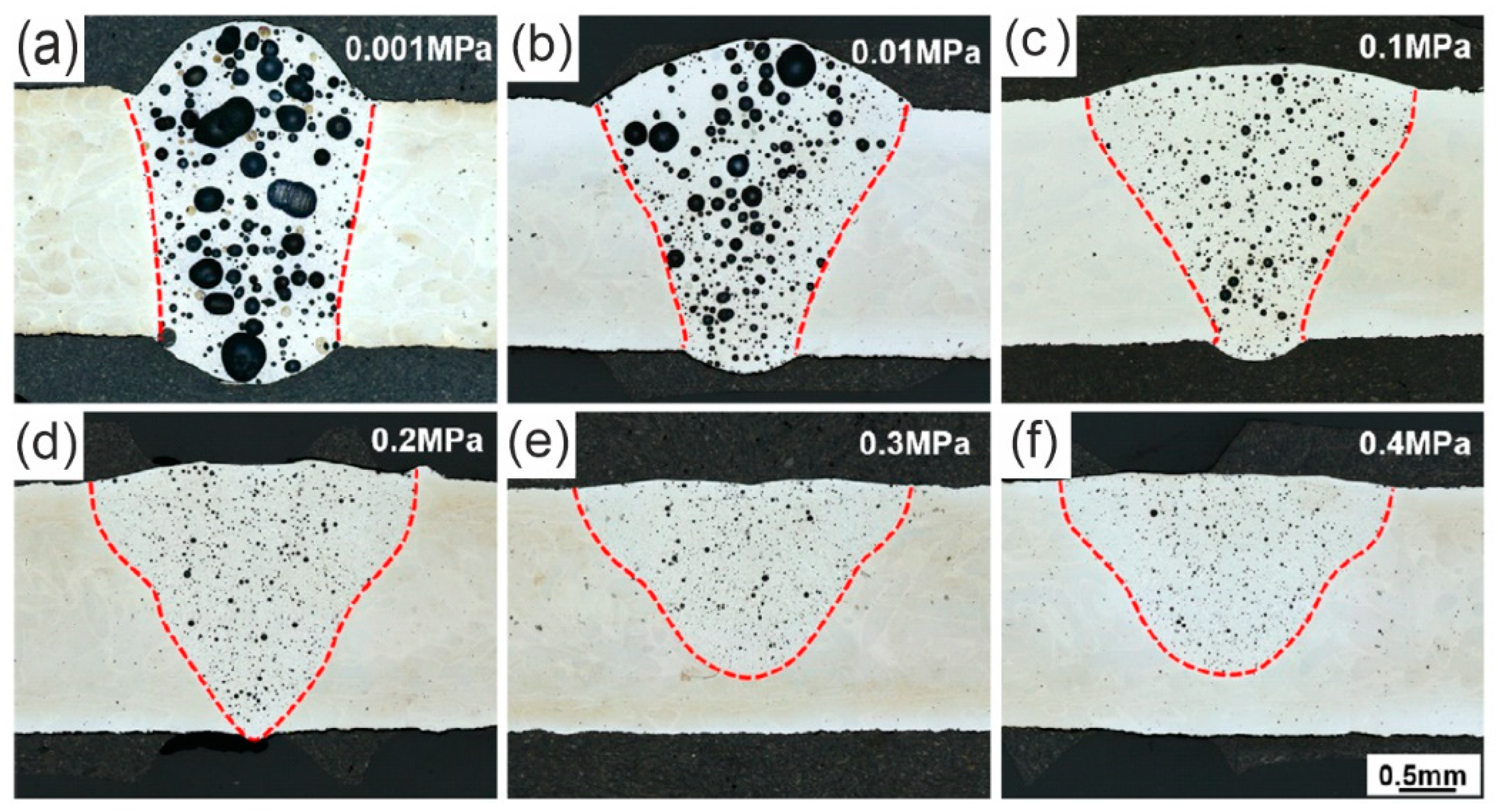
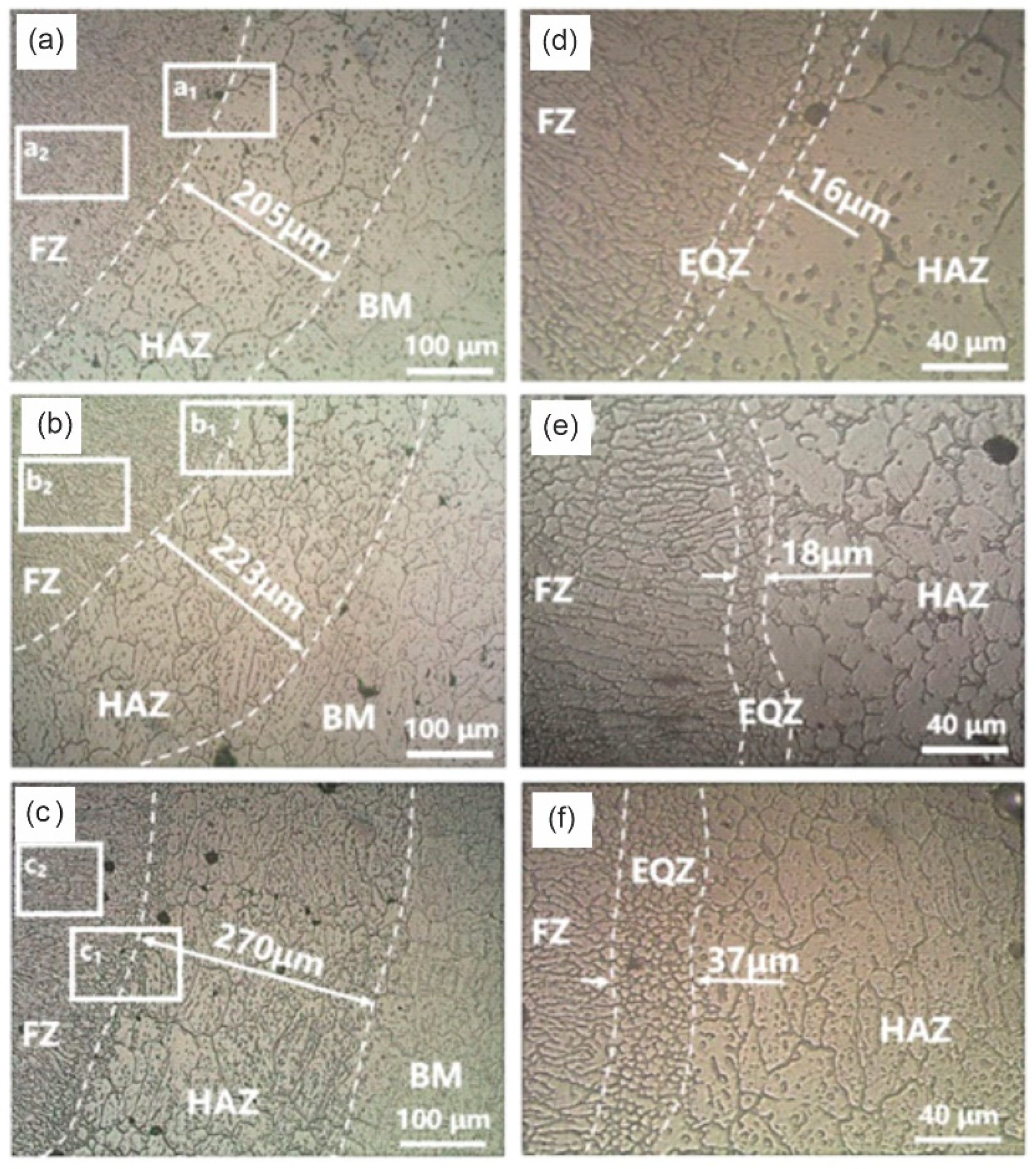
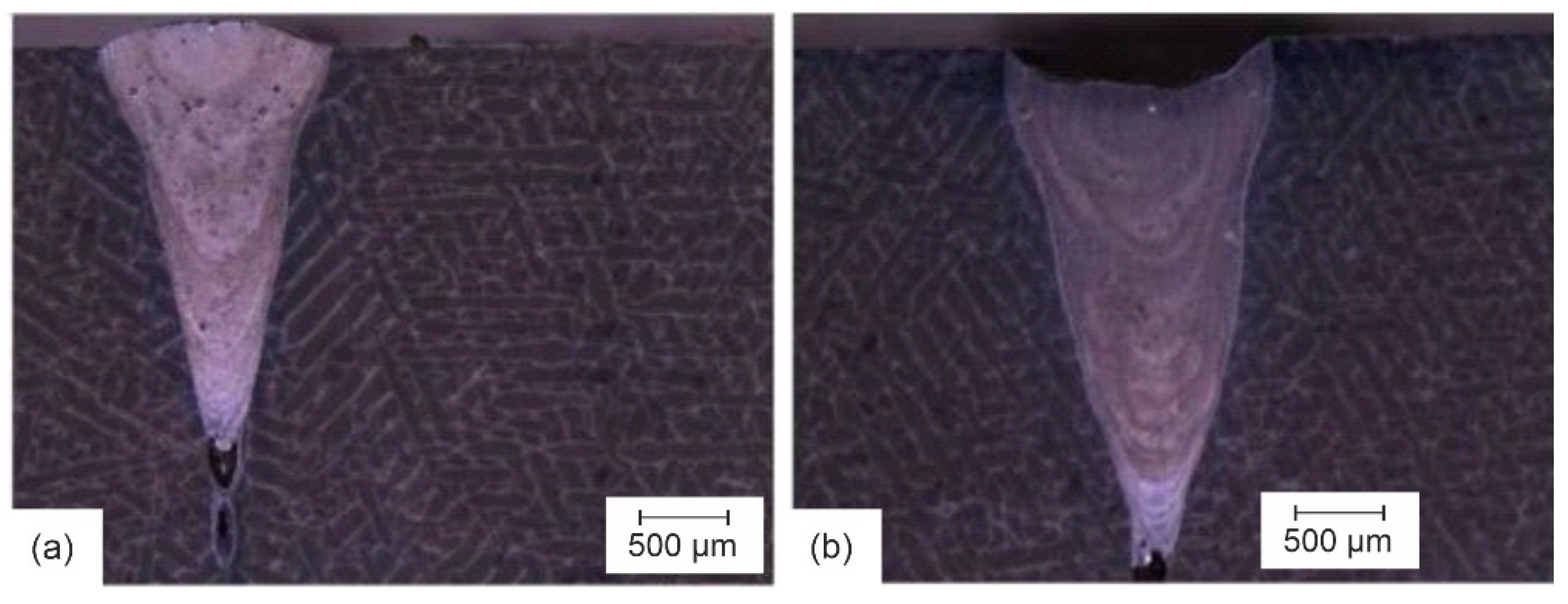
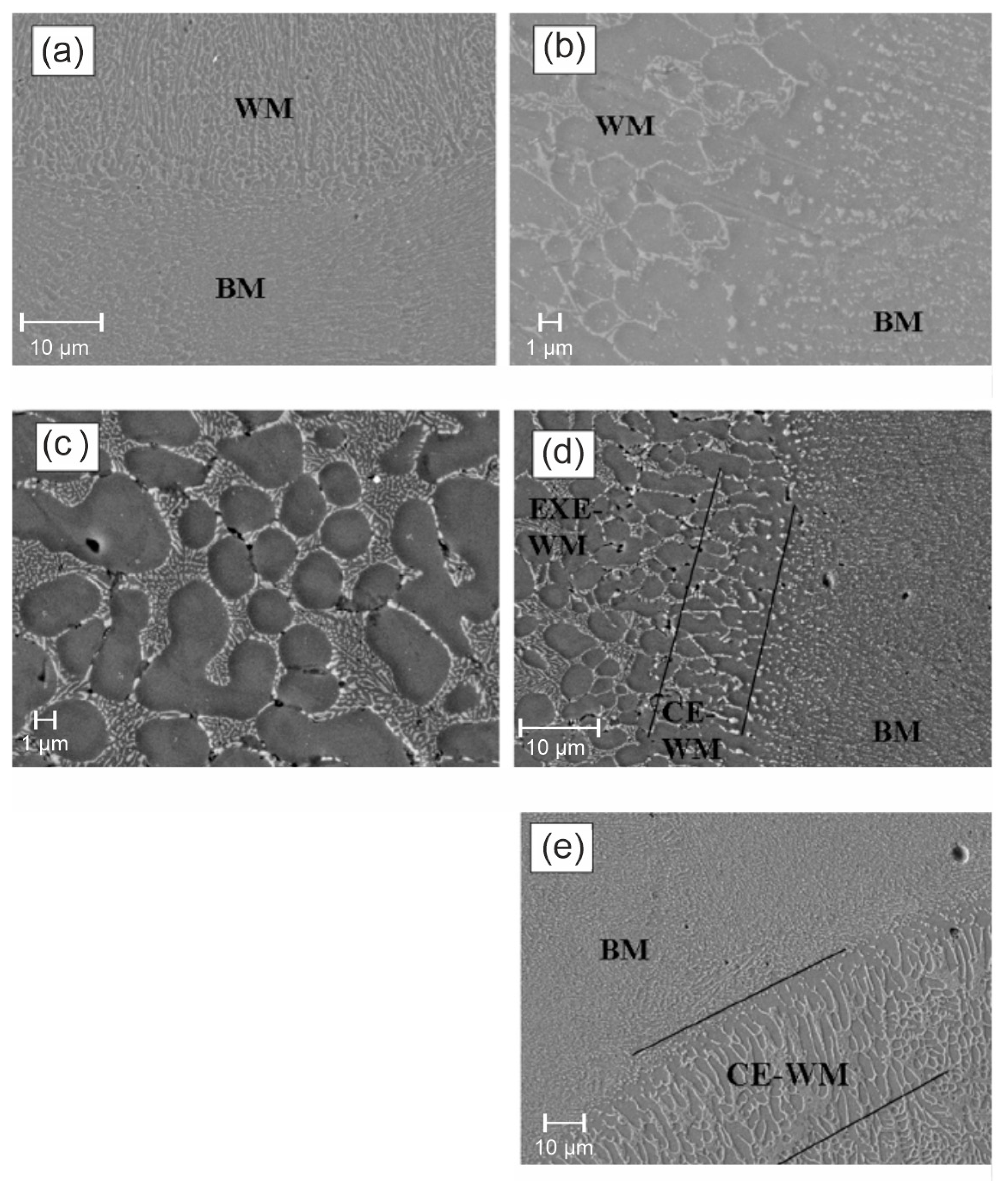
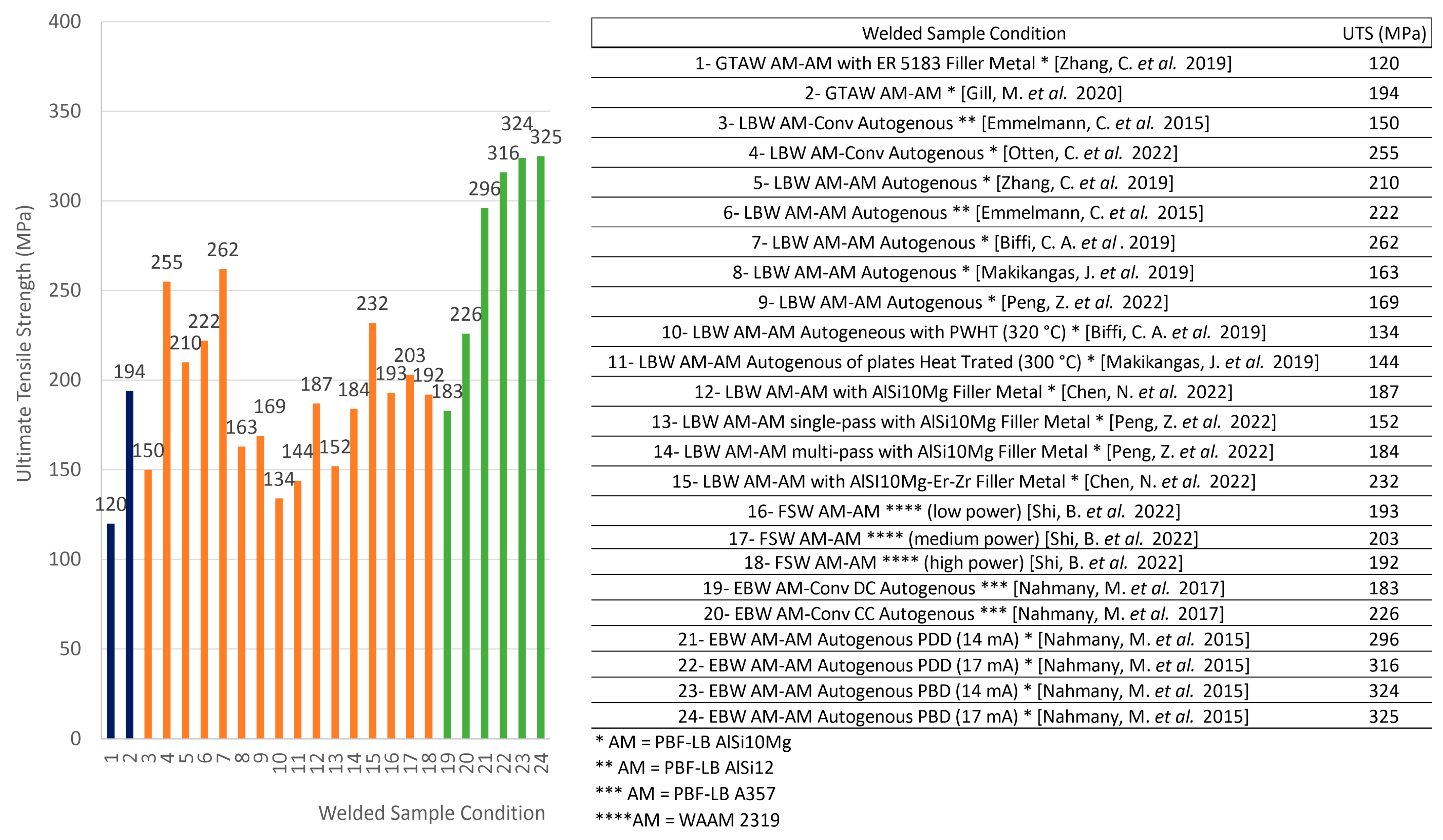
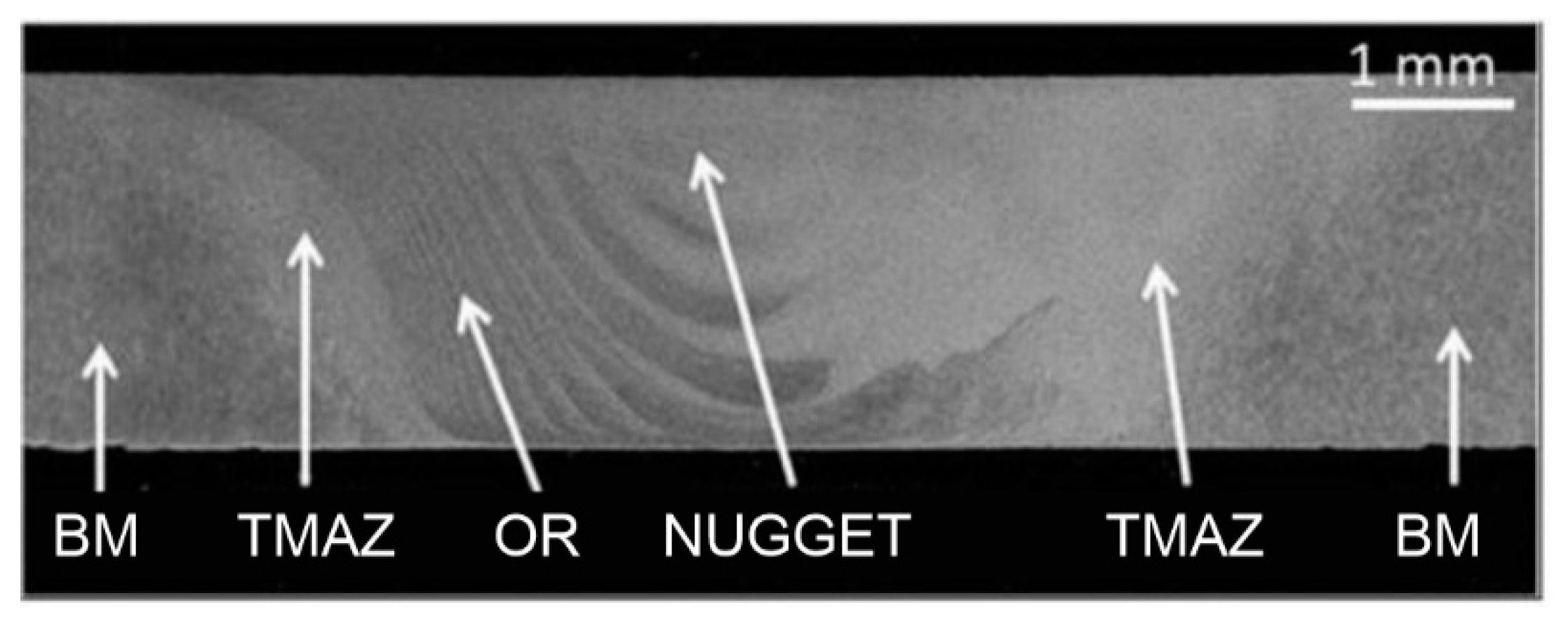
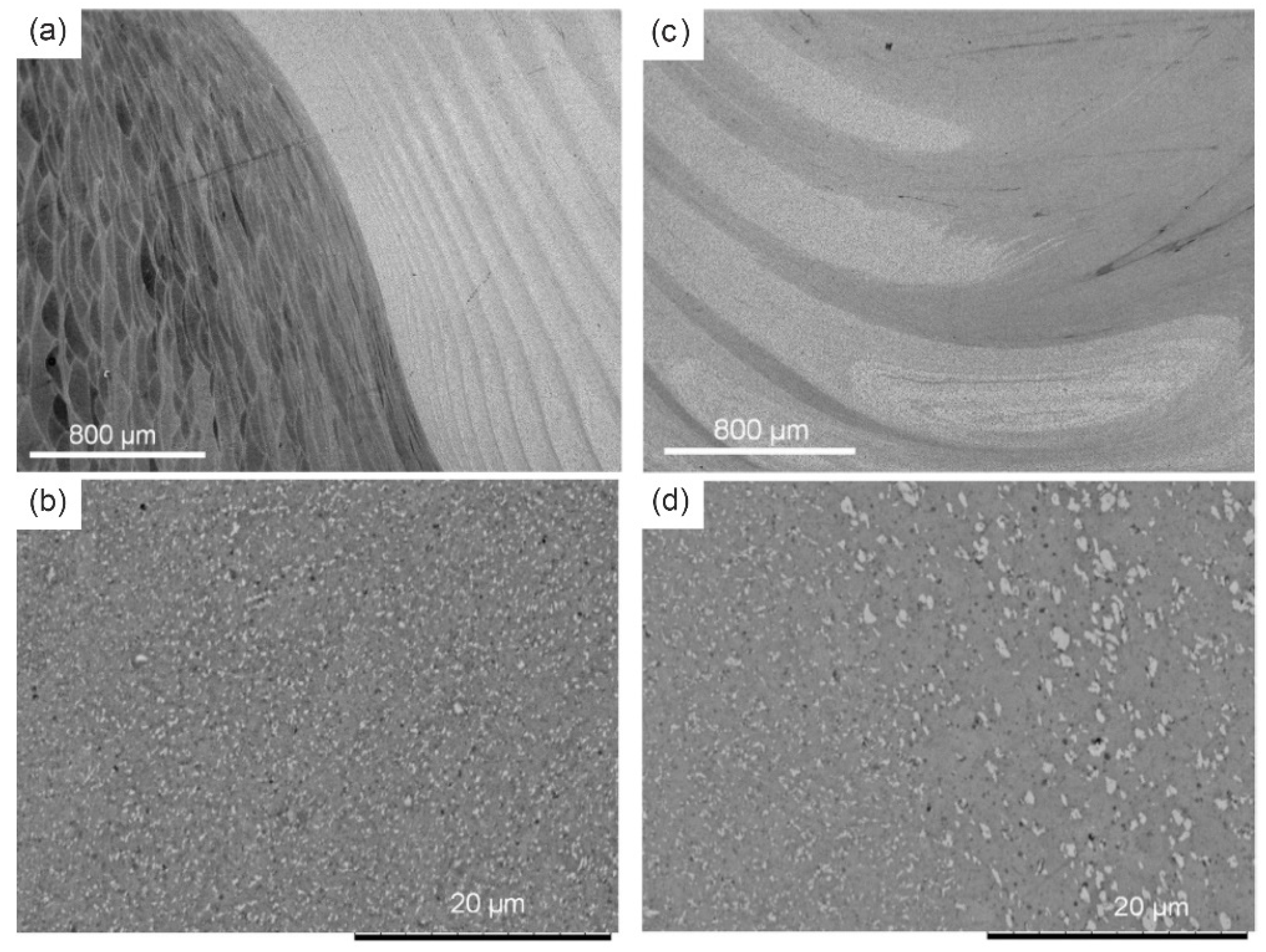
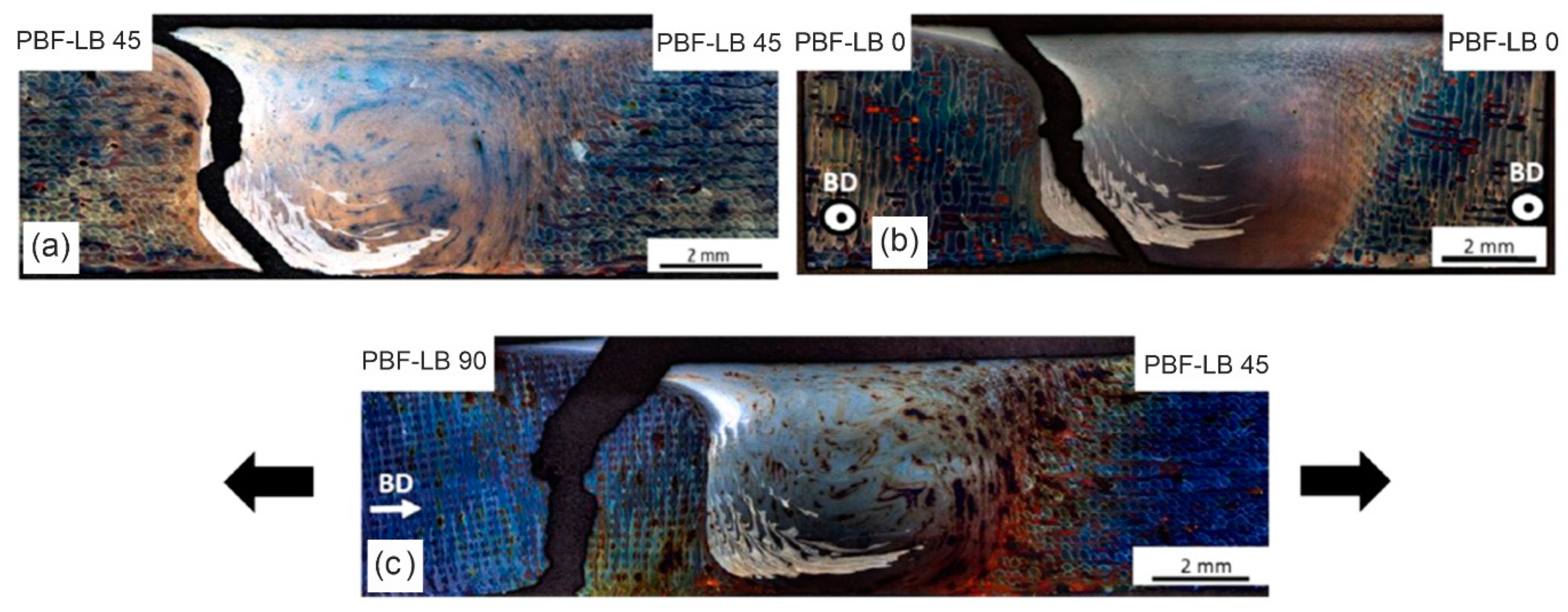
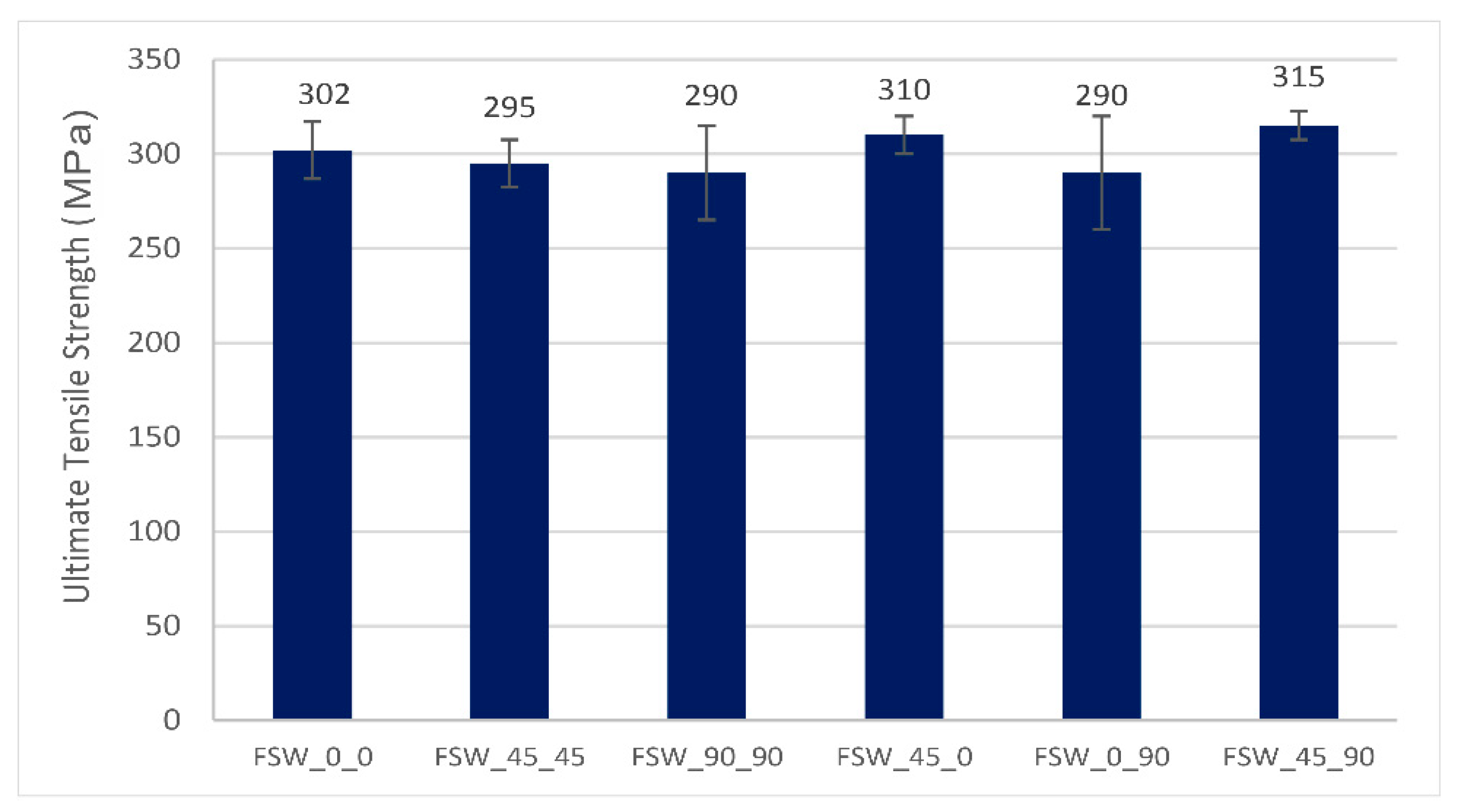


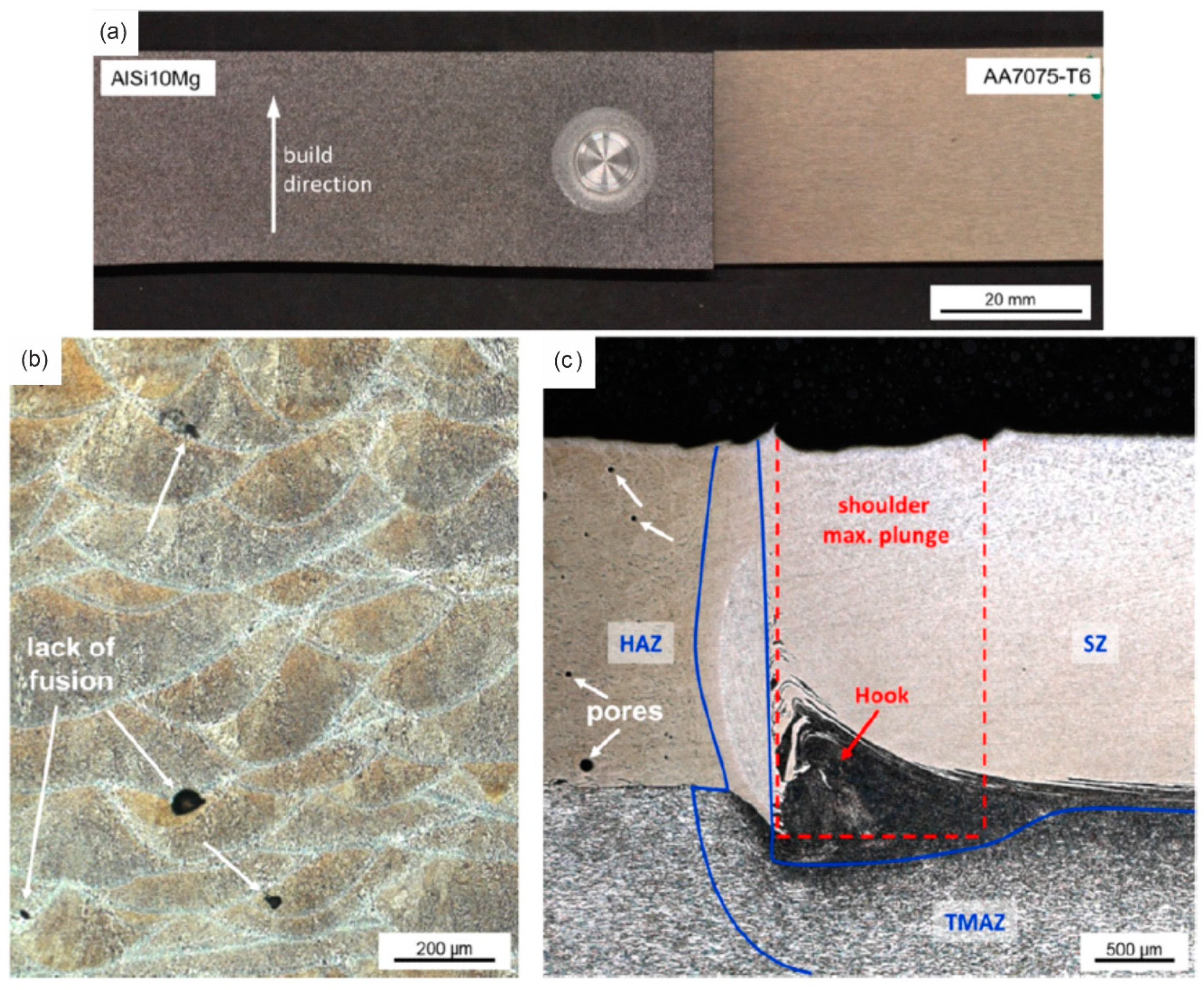


| Title | Publishing Year | Author’s and Co-Author’s Country | Welding Joining Process | AM Process | Material Combination | Typical Challenge/Defect | Proposed Solution for Quality Improvement | Main Achieved Results | Reference |
|---|---|---|---|---|---|---|---|---|---|
| High Levels of Porosity in TIG Welds Made Between Additively Manufactured Aluminium Components | 2020 | UK | Gas Tungsten Arc Welding (GTAW) | PBF-LB and WAAM | (1) PBF-LB AlSi10Mg + PBF-LB AlSi10Mg (2) PBF-LB AlSi10Mg + Wrought AA6061-T6 (3) WAAM AlSi12 + WAAM AlSi12 (4) WAAM AlSi12 + Wrought AA6061-T6 | Porosity | Evaluation of the weldability of aluminium parts manufactured by PBF-LB and WAAM by GTAW process | [35] | |
| A Comparison Between Laser and TIG Welding of Selective Laser MeltedAlSi10Mg | 2019 | China | Gas Tungsten Arc Welding (GTAW) and Laser Beam Welding (LBW) | PBF-LB | (1) PBF-LB AlSi10Mg + PBF-LB AlSi10Mg (2) PBF-LB AlSi10Mg + Cast AlSi10Mg (3) Cast AlSi10Mg + Cast AlSi10Mg | Porosity | Evaluation of the weldability of aluminium parts manufactured by PBF-LB by GTAW LBW processes | [36] | |
| Joining Technologies for Metal Additive Manufacturingin the Energy Industry | 2020 | USA | Gas Tungsten Arc Welding (GTAW) and Friction Stir Welding (FSW) | PBF-LB | PBF-LB AlSi10Mg + PBF-LB AlSi10Mg | GTAW weld: Porosity; FSW weld: Softening on the HAZ | Evaluation of the weldability of aluminium parts manufactured by PBF-LB by GTAW and FSW process | [37] | |
| Hybrid Lightweight Design by Laser Additive Manufacturing and Laser Welding Processes | 2015 | Germany | Laser Beam Welding (LBW) | PBF-LB | (1) PBF-LB AlSi12 + PBF-LB AlSi12 (2) PBF-LB AlSi12 + Conv Cast AlSi12 | Porosity | Evaluation of the weldability of aluminium parts manufactured by PBF-LB by LBW process | [38] | |
| Laser Weldability of AlSi10Mg Alloy Produced by Selective Laser Melting Microstructure and Mechanical Behavior | 2019 | Italy | Laser Beam Welding (LBW) | PBF-LB | PBF-LB AlSi10Mg + PBF-LB AlSi10Mg | Porosity, high energy required due to the high reflectivity and high thermal conductivity | Evaluation of the weldability of aluminium parts manufactured by PBF-LB by LBW process | [39] | |
| Optimization of the Weldability of Laser Additive Manufactured Aluminum by Means of Hydrogen Minimization in the Component and Welding Parameter Optimization | 2019 | Germany | Laser Beam Welding (LBW) | PBF-LB | PBF-LB Al12Si + PBF-LB Al12Si | Porosity | Parameters optimization, and higher quality criteria for the feedstock powder | Optimization of heat input has a slight influence on the porosity level (from 27.0% to 20.0%). Tandem and transversal laser beam configuration result in a higher porosity level. Pre-heating of the plates has a significant reduction in the porosity level (from 19.0% to 12.5% for a pre-heating of 200 °C). The usage of new or recycled powder in the PBF-LB process has a high influence on the porosity level in the posterior welds, of 27.0% and 11.0%, respectively | [40] |
| Weld Morphology, Microstructure Evolution, and Mechanical Properties of Laser Beam Welding of Wire Arc Additive Manufactured Al-Cu Substrate | 2022 | China | Laser Beam Welding (LBW) | WAAM | WAAM 2319 + WAAM 2319 | Evaluation of LBW welding applied to WAAM manufactured parts, and process parameters optimization. Optimized results were achieved by using 3500 W of Laser power | [41] | ||
| Optimization of Laser Welding Process for Laser Additive Manufactured Aluminum Parts by Means of Beam Oscillation and Process-Oriented Component Design | 2017 | Germany | Laser Beam Welding (LBW) | PBF-LB | PBF-LB AlSi10Mg + PBF-LB AlSi10Mg | Porosity | Parameters optimization, and post-processing of the PBF-LB plates | Multi-mode LBW presented a lower porosity level, especially using small amplitude values. Higher welding speed presented a lower porosity level. Post-processing of the PBF-LB plates did not show improvement in the porosity level | [42] |
| Porosity, Microstructure and Mechanical Property of Welded Joints Produced by Different Laser Welding Processes in Selective Laser Melting AlSi10Mg Alloys | 2022 | China | Laser Beam Welding (LBW) | PBF-LB | (1) PBF-LB AlSi10Mg + PBF-LB AlSi10Mg (2) Cast AlSi10Mg + Cast AlSi10Mg | Porosity | LBW with Powder Feeding | Reduction in the porosity level from 7.0% to 1.85%. Increase of the micro-hardness from 85.0~95.4 HV to 93.0~101.5 HV. Increase of the UTS from 169.3 MPa to 184.0 MPa | [43] |
| Effect of Er and Zr Addition on Laser Weldability of Alsi10Mg Alloys Fabricated by Selective Laser Melting | 2022 | China | Laser Beam Welding (LBW) | PBF-LB | PBF-LB AlSi10Mg + PBF-LB AlSi10Mg | Porosity | Addition of Er and Zr in the LBW filler metal | Reduction in the porosity level from 11.8% to 8.1%, and maximum pore size from 370 µm to 108 µm. Increase of the hardness from 95 HV to 103 HV, and UTS from 209 MPa to 231.5 MPa | [44] |
| Innovative Laserschweibtechnologie Fur Additiv Gefertigde Bauteile | 2021 | Germany | Laser Beam Welding (LBW) | PBF-LB | PBF-LB AlSi10Mg + PBF-LB AlSi10Mg | Porosity | Performing the LBW process under vacuum | Reduction in the porosity level when compared to the conventional LBW process | [45] |
| Welding of Additive Manufactured AlSi10Mg: Using Laser Welding in A Vacuum for High Quality Weld Seams - A New Approach to Welding LPBF Manufactured Alsi10Mg | 2021 | Germany, South Africa | Laser Beam Welding (LBW) | PBF-LB | PBF-LB AlSi10Mg + Conv EN AW-5083 | Porosity | Performing the LBW process under vacuum in combination to beam oscillation and multiple passes | The combination of vacuum laser with a beam oscillation and multiple passes of the laser seams to decrease porosity from 1.2 to 0.3% in weld while at the same time increasing the weld depth from 1.6 to 2.3 mm | [46] |
| Effect of Ambient Pressure on Laser Welding of AlSi10Mg Fabricated by Selected Laser Melting | 2022 | China, USA | Laser Beam Welding (LBW) | PBF-LB | PBF-LB AlSi10Mg + PBF-LB AlSi10Mg | Porosity | Welding under high pressure | Reduction in the porosity level from 10.2% to 2.3%, and in the dominant pore size from 50-100 µm to 10-20 µm | [47] |
| Laser Welding of AlSi10Mg Aluminium-Based Alloy Produced by Selective Laser Melting (SLM) | 2019 | Finland | Laser Beam Welding (LBW) | PBF-LB | PBF-LB AlSi10Mg + PBF-LB AlSi10Mg | Porosity | Heat Treatment | Reduction in the UTS by using heat treatment from 163 to 144 MPa | [48] |
| Weldability and Mechanical Properties of Dissimilar Laser Welded AluminumAlloys Thin Sheets Produced by Conventional Rolling andAdditive Manufacturing | 2022 | Italy | Laser Beam Welding (LBW) | PBF-LB | PBF-LB A357 + Conv 6082-T6 | Porosity | Process and post-process parameters optimization, such as welding speed, PBF-LB sheet orientation and post build heat treatment | Lower porosity level while working at welding speed of 80 mm/s, The post build heat treatment (T6) of PBF-LB sheet has the strongest influence on final properties of the joint, while building orientation do not induce significant effects over the tested range | [49] |
| Fatigue Assessment of Additively Manufactured AlSi10Mg Laser Beam Weldedto Rolled EN AW-6082-T6 Sheet Metal | 2020 | Germany | Laser Beam Welding (LBW) | PBF-LB | PBF-LB AlSi10Mg + Conv EN AW-6082-T6 | Porosity | Fatigue evaluation of welds between conventionally and PBF-LB parts manufactured welded by LBW | [50] | |
| Electron Beam Welding of AlSi10Mg Workpieces Produced By Selective Laser Melting Additive Manufacturing Technology | 2015 | Israel | Electron Beam Welding (EBW) | PBF-LB | PBF-LB AlSi10Mg + PBF-LB AlSi10Mg | Porosity | Parameters optimization | Lower porosity level while working in a conduction regime (low power density) | [51] |
| Structural Properties of EB-Welded AlSi10Mg Thin-Walled Pressure Vessels Produced by AM-SLM Technology | 2017 | Israel | Electron Beam Welding (EBW) | PBF-LB | PBF-LB AlSi10Mg + PBF-LB AlSi10Mg | Porosity | Parameters optimization | Lower porosity level while working in a conduction regime (low power density) | [52] |
| Microstructural Assessment and Mechanical Properties of Electron Beam Welding of AlSi10Mg Specimens Fabricated By Selective Laser Melting | 2019 | Israel | Electron Beam Welding (EBW) | PBF-LB | PBF-LB AlSi10Mg + PBF-LB AlSi10Mg | Porosity | Parameters optimization | Lower porosity level while working in a conduction regime (low power density) | [53] |
| Investigation of Pore Reduction in Hydrib Joints of Conventionally and Additively Manufactured AlSi10Mg Using Electron Beam Welding | 2021 | Germany | Electron Beam Welding (EBW) | PBF-LB | (1) PBF-LB AlSi10Mg + Conv DC AlSi10Mg (2) PBF-LB AlSi10Mg + Conv CC AlSi10Mg | Porosity | Parameters optimization by beam offset and multi-spot welding | Porosity reduction while using EB three-spot welding technique | [54] |
| On The Microstructure Analysis of FSW Joints of Aluminium Components Made viaDirect Metal Laser Sintering | 2017 | Italy | Friction Stir Welding (FSW) | PBF-LB | PBF-LB AlSi10Mg + PBF-LB AlSi10Mg | Evaluation of FSW welding applied to PBF-LB manufactured parts. Satisfactory results were achieved regarding microstructural homogeneity and hardness | [55] | ||
| Friction Stir Welding of AlSi10Mg Plates Produced by Selective Laser Melting | 2018 | Italy | Friction Stir Welding (FSW) | PBF-LB | PBF-LB AlSi10Mg + PBF-LB AlSi10Mg | Evaluation of FSW welding applied to PBF-LB manufactured parts. Satisfactory results were achieved regarding microstructural homogeneity and hardness | [56] | ||
| Study of the Solid State Joining of Additive Manufactured Components | 2017 | Italy | Friction Stir Welding (FSW) | PBF-LB | PBF-LB AlSi10Mg + PBF-LB AlSi10Mg | Evaluation of FSW welding applied to PBF-LB manufactured parts. Satisfactory results were achieved regarding microstructural homogeneity and hardness | [57] | ||
| Investigation of Porosity Reduction, Microstructure and Mechanical Properties for Joining of Selective Laser Melting Fabricated Aluminium Composite via Friction Stir Welding | 2018 | Singapore | Friction Stir Welding (FSW) | PBF-LB | PBF-LB AlSi10Mg + PBF-LB AlSi10Mg | Low mechanical properties caused by softening in the weld nugget and TMAZ | Addition of 2% wt. nAl2O3 to the AlSi10Mg PBF-LB powder. Process parameter optimization by increasing heat input | The addition of nAl2O3 to the PBF-LB powder achieved the following results in the weld: Increase in the porosity level from 0.07% (low HI) and 0.06 (high HI) to 0.10% (low HI) and 0.16% (high HI); increase in the microhardness from 68 HV (low HI) and 67 HV (high HI) to 75 HV (low HI) and 74 (high HI); and decrease in the UTS from 238 MPa (low HI) and 240 MPa (high HI) to 146 MPa (low HI) and 135 MPa (high HI) | [58] |
| Assessment of Friction Stir Welding on Aluminium 3D Printing Materials | 2019 | Malaysia | Friction Stir Welding (FSW) | PBF-LB | (1) PBF-LB AlSi10Mg + PBF-LB AlSi10Mg (2) PBF-LB AlSi10Mg-2% wt. nAl2O3 + PBF-LB AlSi10Mg-2% wt. nAl2O3 | Low mechanical properties caused by softening in the weld nugget and TMAZ | Review the weldability of PBF-LB AlSi10Mg alloys using the FSW process. Addition in 2% wt. nAl2O3 increases the hardness in the weld nugget and TMAZ | [59] | |
| Joining of 3D-Printed AlSi10Mg by Friction Stir Welding | 2018 | Singapore | Friction Stir Welding (FSW) | PBF-LB | PBF-LB AlSi10Mg + PBF-LB AlSi10Mg | Softening in the weld nugget, due to the dissolution of hardening precipitates in the aluminium matrix | Parameters optimization | Increasing strength and hardness using higher heat input, by modifying the welding speed and downward force | [60] |
| Enhancing the Properties of Friction Stir Welded Joints of L-PBF Printed AlSi10Mg Alloy via Multi-Variable Optimization | 2023 | India | Friction Stir Welding (FSW) | PBF-LB | PBF-LB AlSi10Mg + PBF-LB AlSi10Mg | Process parameters optimization by varying tool rotation speed, tool tilt, and tool transverse speed. Optimized results (UTS of 234 MPa) were achieved using 984 RPM of tool rotational speed, 0° of tool tilt angle, and 63 mm/min | [61] | ||
| Influence of Tool Rotational Speed on the Microstructural Characterization and Mechanical Properties of Friction Stir Welded Al-Si10Mg Parts Produced by DMLS Additive Manufacturing Process | 2022 | India | Friction Stir Welding (FSW) | PBF-LB AlSi10Mg + PBF-LB AlSi10Mg | Evaluation of the effect of tool rotation speeds (900 RPM, 1200 RPM, and 1500 RPM) on the FSW joint quality. The optimized results were achieved using the rotational speed of 900 RPM | [62] | |||
| On The Influence Of Build Orientation on Properties of Friction Stir Welded AlSi10Mg Parts Producedby Selective Laser Melting | 2021 | Germany | Friction Stir Welding (FSW) | PBF-LB | PBF-LB AlSi10Mg + PBF-LB AlSi10Mg | Softening in the weld nugget, the TMAZ, and HAZ | Evaluation of the weldability of aluminium parts manufactured by PBF-LB by FSW process | [63] | |
| FSW of Extruded and Additively Manufactured Parts for Automotive Components | 2023 | Italy | Friction Stir Welding (FSW) | PBF-LB AlSi10Mg + Extruded AA6063-T6 | Evaluation of FSW applied to PBF-LB manufactured parts using lap joint configuration | [64] | |||
| On The Low-Cycle Fatigue Behavior of Friction Stir Welded AlSi12 PartsProduced by Selective Laser Melting | 2019 | Germany, USA | Friction Stir Welding (FSW) | PBF-LB | PBF-LB Al12Si + PBF-LB Al12Si | Softening in the SZ and HAZ, impacting the mechanical properties of the weld | Evaluation of FSW welding applied to PBF-LB parts, regarding microstructural evolution, tensile properties, and Low Cycle Fatigue properties | [65] | |
| Untersuchung und Witerentwicklung von Reibschweiss-verfahren zum Verbiden Additiv Gefertigter Bauteile | 2022 | Germany | Friction Stir Welding (FSW) | PBF-LB | PBF-LB AlSi10Mg + PBF-LB AlSi10Mg | Evaluation of FSW welding applied to PBF-LB manufactured parts and process parameters optimization. Optimized results were achieved by using a rotational speed of 400 RPM and a welding speed of 400 mm/min | [66] | ||
| Microstructural And Mechanical Properties of AlSi10Mg: Hybrid Welding of Additively Manufactured and Cast Parts | 2022 | Germany | Friction Stir Welding (FSW) | PBF-LB | (1) PBF-LB AlSi10Mg + Cast AlSi10Mg (2) PBF-LB AlSi10Mg + PBF-LB AlSi10Mg (3) Cast AlSi10Mg + Cast AlSi10Mg | Evaluation of FSW welding applied to different material combinations. Satisfactory results with no welding defects were achieved regarding hardness, tensile strength, fatigue lifetime | [67] | ||
| Strength and Microstructure of Friction Stir Welded Additively Manufactured Scalmalloy® is As-Welded and Heat-Treated Conditions | 2023 | Italy | Friction Stir Welding (FSW) | PBF-LB | PBF-LB Scalmalloy® + PBF-LB Scalmalloy® | Evaluation of FSW welding applied to PBF-LB manufactured Scalmalloy®, and process parameters optimization | The build direction slightly influences the joint mechanical properties. Tensile tests were performed on perpendicular and parallel to deposition direction to the layers, achieving a UTS of 385 MPa and 375 MPa, respectively | [68] | |
| Microstructure and Mechanical Properties of Dissimilar Friction Stir Welded Joints of Laser Powder Bed Fusion Processed AlSi10Mg and Conventional Hot Rolled 6061-T6 Thin Sheets | 2023 | India, South Africa | Friction Stir Welding (FSW) | PBF-LB | PBF-LB AlSi10Mg + Conv HR 6061-T6 | Evaluation of FSW welding applied to PBF-LB manufactured to conventionally manufactured hot rolling parts. The highest UTS of 206 MPa was achieved by using high heat input, and the PBF-LM part on the advancing side | [69] | ||
| Friction Stir Welding of Wire Arc Additively Manufactured 205A Aluminum Alloy: Microstructure and Mechanical Properties | 2023 | China, Australia | Friction Stir Welding (FSW) | WAAM | WAAM ER205A + Conv 2219 | Evaluation of FSW welding applied to WAAM manufactured parts. Compared to the as-build WAAM part, the weld presented: a decrease in the UTS from 236.6 MPa to 224.4 MPa, an increase in the yield strength from 102.8 MPa to 116.2 MPa, and in the elongation from 7.78% to 9% | [70] | ||
| Refill Friction Stir Spot Welding of AlSi10Mg Alloy Produced by Laser Powder Bed Fusion to Wrought AA7075-T6 Alloy | 2022 | Austria, UK | Refill Friction Stir Spot Welding (RFSSW) | PBF-LB | PBF-LB AlSi10Mg + Wrought AA7075-T6 | Softening in the hook region of the thermo-mechanically affected zone | Parameters Optimization | Medium heat input welds showed the best weld quality and mechanical properties | [71] |
| Friction Welding of Al–12Si Parts Produced by Selective Laser Melting | 2014 | Germany, India | Rotational Friction Welding (RFW) | PBF-LB | PBF-LB Al12Si + PBF-LB Al12Si | Evaluation of FSW welding applied to PBF-LB manufactured parts. Compared to the as-build PBF-LB part, the weld presented: a decrease in the yield strength from 260 MPa to 215 MPa, an increase in the elongation from 3% to 10% | [72] | ||
| MP Welding of Dissimilar Materials: AM Laser Powder-Bed Fusion AlSi10Mg to Wrought AA6060-T6 | 2020 | Israel | Magnetic Pulse Welding (MPW) | PBF-LB | PBF-LB AlSi10Mg + Wrought AA6060-T6 | Evaluation of MPW welding applied to PBF-LB manufactured parts. The achieved results show that the MPW is a feasible technique for this joining combination. The best results were achieved using the optimized parameters: 9.7 kJ of discharge energy, and 2.5 mm of stand-off distance using a single-turn coil. Microhardness tests revealed a typical limited hardening in the region adjacent to the joint, probably due to the severe plastic deformation | [73] | ||
Disclaimer/Publisher’s Note: The statements, opinions and data contained in all publications are solely those of the individual author(s) and contributor(s) and not of MDPI and/or the editor(s). MDPI and/or the editor(s) disclaim responsibility for any injury to people or property resulting from any ideas, methods, instructions or products referred to in the content. |
© 2023 by the authors. Licensee MDPI, Basel, Switzerland. This article is an open access article distributed under the terms and conditions of the Creative Commons Attribution (CC BY) license (https://creativecommons.org/licenses/by/4.0/).
Share and Cite
Nunes, R.; Faes, K.; De Waele, W.; Simar, A.; Verlinde, W.; Lezaack, M.; Sneyers, W.; Arnhold, J. A Review on the Weldability of Additively Manufactured Aluminium Parts by Fusion and Solid-State Welding Processes. Metals 2023, 13, 1724. https://doi.org/10.3390/met13101724
Nunes R, Faes K, De Waele W, Simar A, Verlinde W, Lezaack M, Sneyers W, Arnhold J. A Review on the Weldability of Additively Manufactured Aluminium Parts by Fusion and Solid-State Welding Processes. Metals. 2023; 13(10):1724. https://doi.org/10.3390/met13101724
Chicago/Turabian StyleNunes, Rafael, Koen Faes, Wim De Waele, Aude Simar, Wim Verlinde, Matthieu Lezaack, Wout Sneyers, and Julius Arnhold. 2023. "A Review on the Weldability of Additively Manufactured Aluminium Parts by Fusion and Solid-State Welding Processes" Metals 13, no. 10: 1724. https://doi.org/10.3390/met13101724
APA StyleNunes, R., Faes, K., De Waele, W., Simar, A., Verlinde, W., Lezaack, M., Sneyers, W., & Arnhold, J. (2023). A Review on the Weldability of Additively Manufactured Aluminium Parts by Fusion and Solid-State Welding Processes. Metals, 13(10), 1724. https://doi.org/10.3390/met13101724









